
This is our jargon busting A-Z glossary for feed supplements. Behind each letter is an explanation of the commonly used terms related to our supplements. If you need any more information on any of our supplements, please contact us using the Nutritional Advice Line details below.
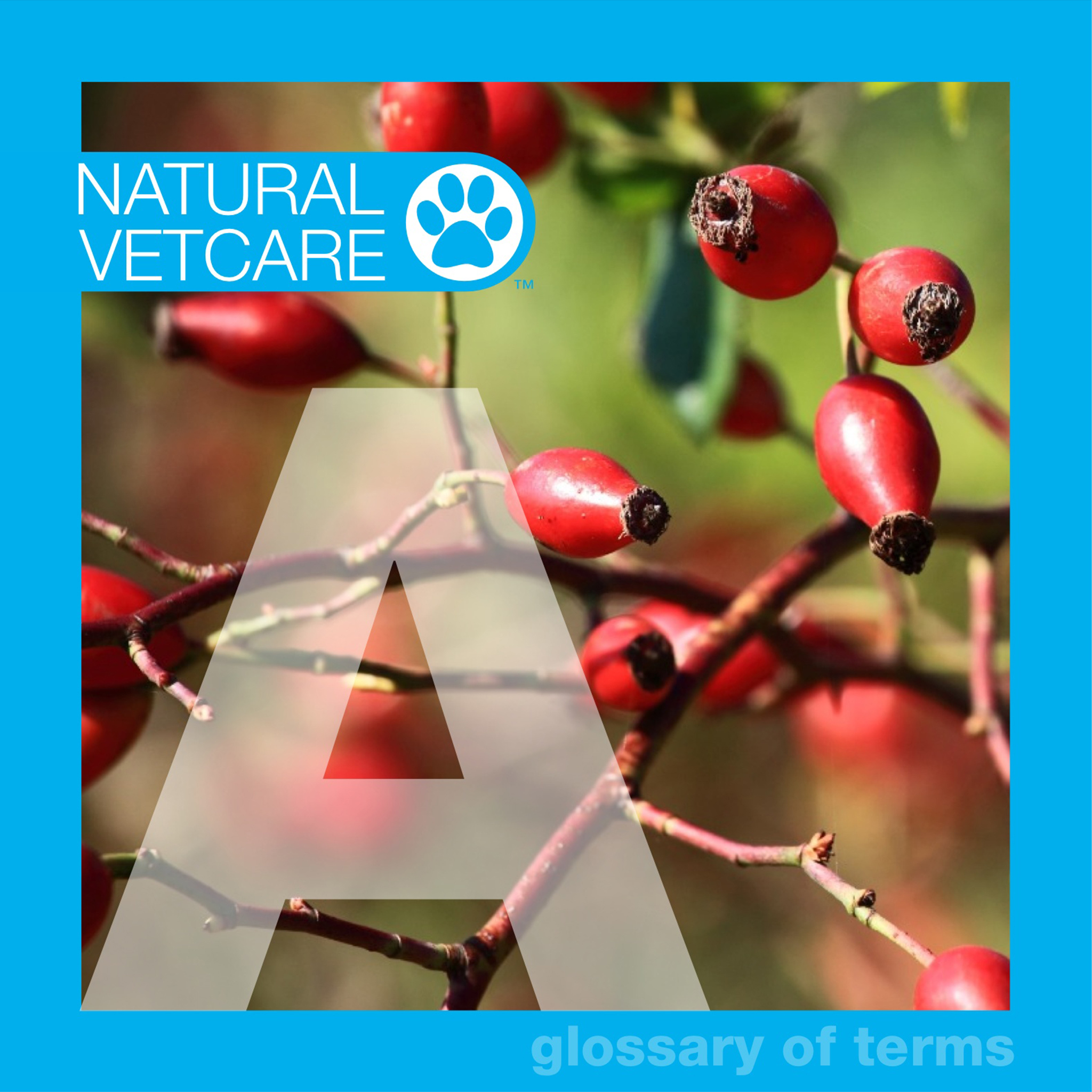
A is for Antioxidants.
Antioxidants are complex compounds that can counteract and neutralise damage within the body. While oxygen is essential to life, an excess - or 'oxidative stress' - can cause significant damage to all cells. Oxidative stress is caused by small, highly charged, 'free radical toxins' which are naturally produced, but which escalate at times of physical challenge. Free radical toxins are a key factor in any type of inflammation, making antioxidants crucial in tackling damage wherever it happens.
Antioxidants include synthetic Vitamin C and E, however research interest is growing in natural antioxidants, such as rosehip and chlorella, as their complex make-up offers much more than a single ingredient strategy. NAF have lead the field in the synergistic power of natural antioxidants in equine health for over thirty years, with published papers dating back to the 1990s (1,2). We advise looking for a blend of natural antioxidants to support the bodyâs response to oxidative stress, whatever the challenge.
1. Larkins N.J (1999) Free radical biology and pathology. Journal of Equine Veterinary Science. 19(2), p84-89, 134-135
2. Knight J & Larkins N.J (2003) Antioxidant status of horses quantified by ABEL® wide-range assay. Proceedings of 42nd BEVA Congress. p.293
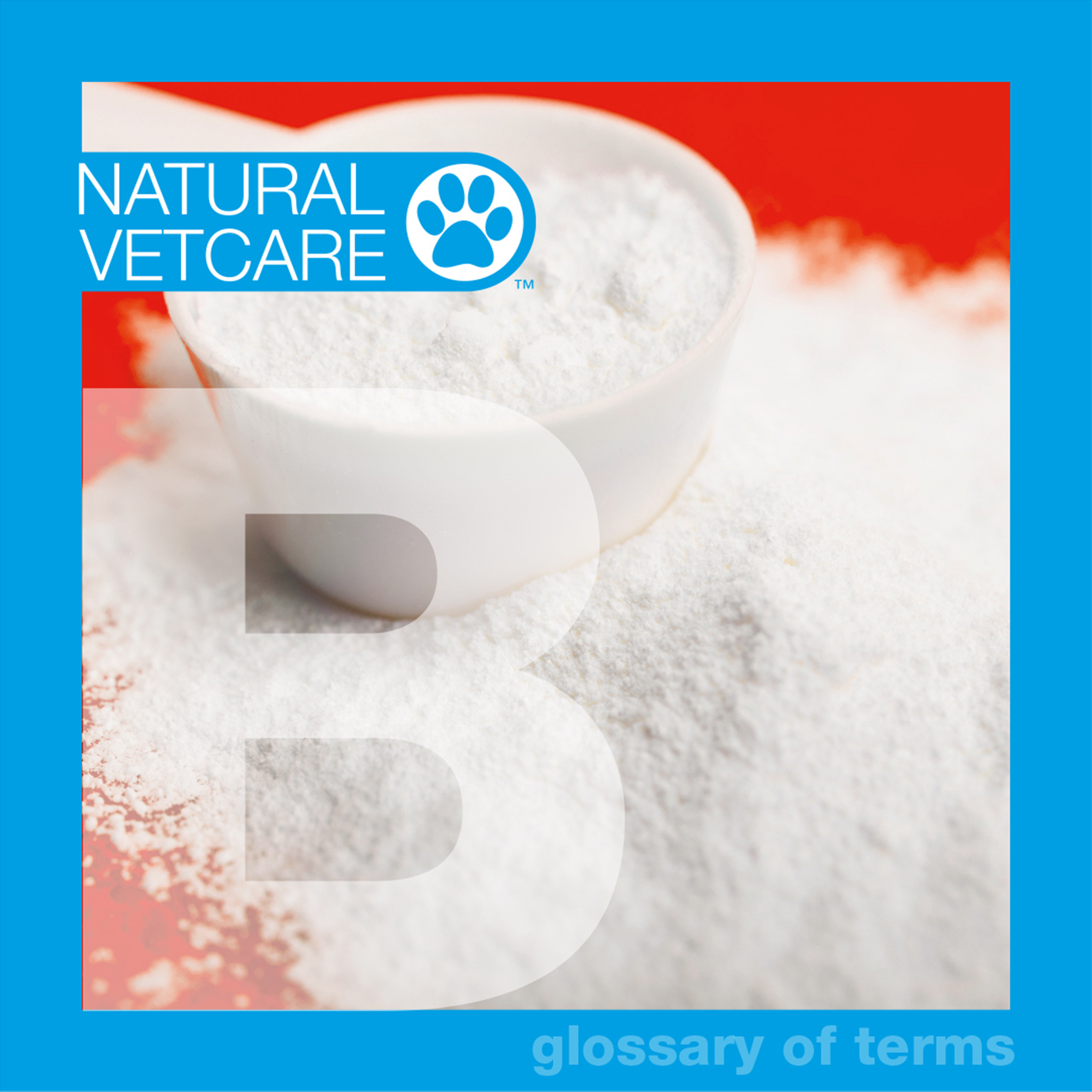
B is for Biotin.
Biotin is one of the water-soluble B vitamins (B7), but better known simply as Biotin or Vitamin H. The 'H' in biotin's name comes from 'Haar and Haut', the German for 'hair and skin', which gives us an idea of it's function. Biotin is well known for skin, hair and nail health, and it's use has long been known in dogs(1).
Microorganisms lower in the gastrointestinal tract can produce biotin naturally. However, absorption in the hindgut is limited, and dogs and cats benefit from dietary sources. Indeed, if biotin is in the diet it is thought to be better absorbed than the naturally produced, as it is able to be absorbed in the small intestine where vitamins are best taken up.
Trials suggest that the benefit comes from the action of biotin increasing synthesis of cytokeratins(2) - proteins found in epithelial tissue, such as nails and skin, which help the cells resist mechanical stress. These proteins feed keratin production, that tough, flexible structure that makes up our hair and nails.
However biotin alone is rarely the answer to skin and nail issues. Therefore it is recommended that when supplementing with biotin look for a blend which also provides important co-factors for hoof health such as sulphur, from MSM, zinc and omega 3 fatty acids such as salmon oil and chlorella.
Selected Sources:
1. Frigg M et al (1989) Clinical study on the effect of biotin on skin conditions in dogs. Schwiez Arch Tierheikd. 131(10) 621-5
2. Fritsche et al (1991) Pharmacological effects of biotin on epidermal cells. Schweizer Archiv Fur Thierheilkunde 133(6), 277-83
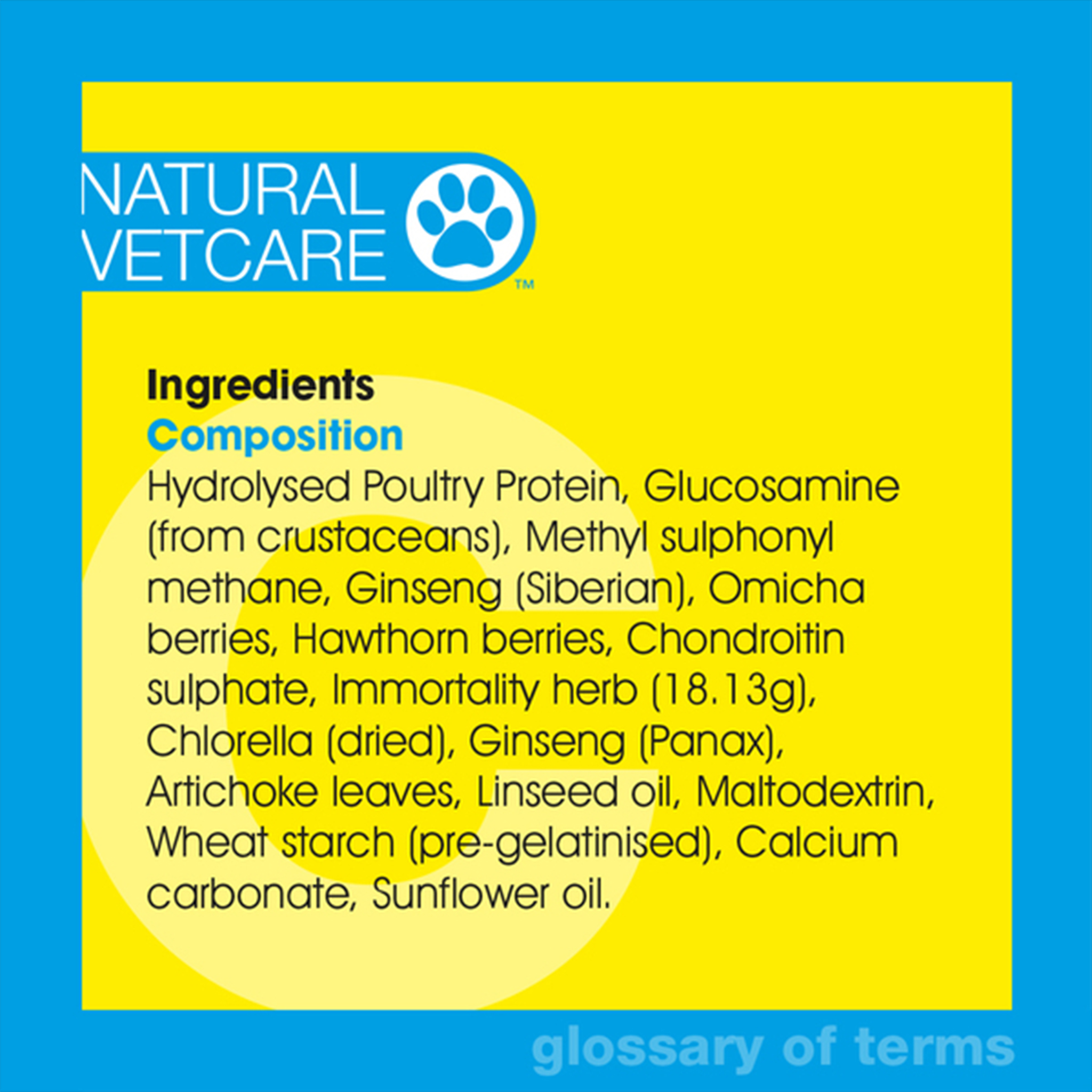
C is for Composition.
Composition is a legal requirement on all feed labels, including feed supplements, and must show the full listing of the 'feed materials' in the product. Feed materials are ingredients that provide nutritive value, for example, energy, protein, carbohydrates, fat and sugars. These are in contrast to the 'Additives', like vitamins or trace elements, which are the technical ingredients.
Composition in horse feed will include forages, cereals, herbs, and other plants; joint support, such as glucosamine, antacids, prebiotics and major minerals. Legally the manufacturer is not obliged to list their inclusion amount, as that would effectively reveal their recipe. However, manufacturers are legally required to list Composition ingredients in inclusion order, i.e. the biggest ingredient will come first down to the smallest.
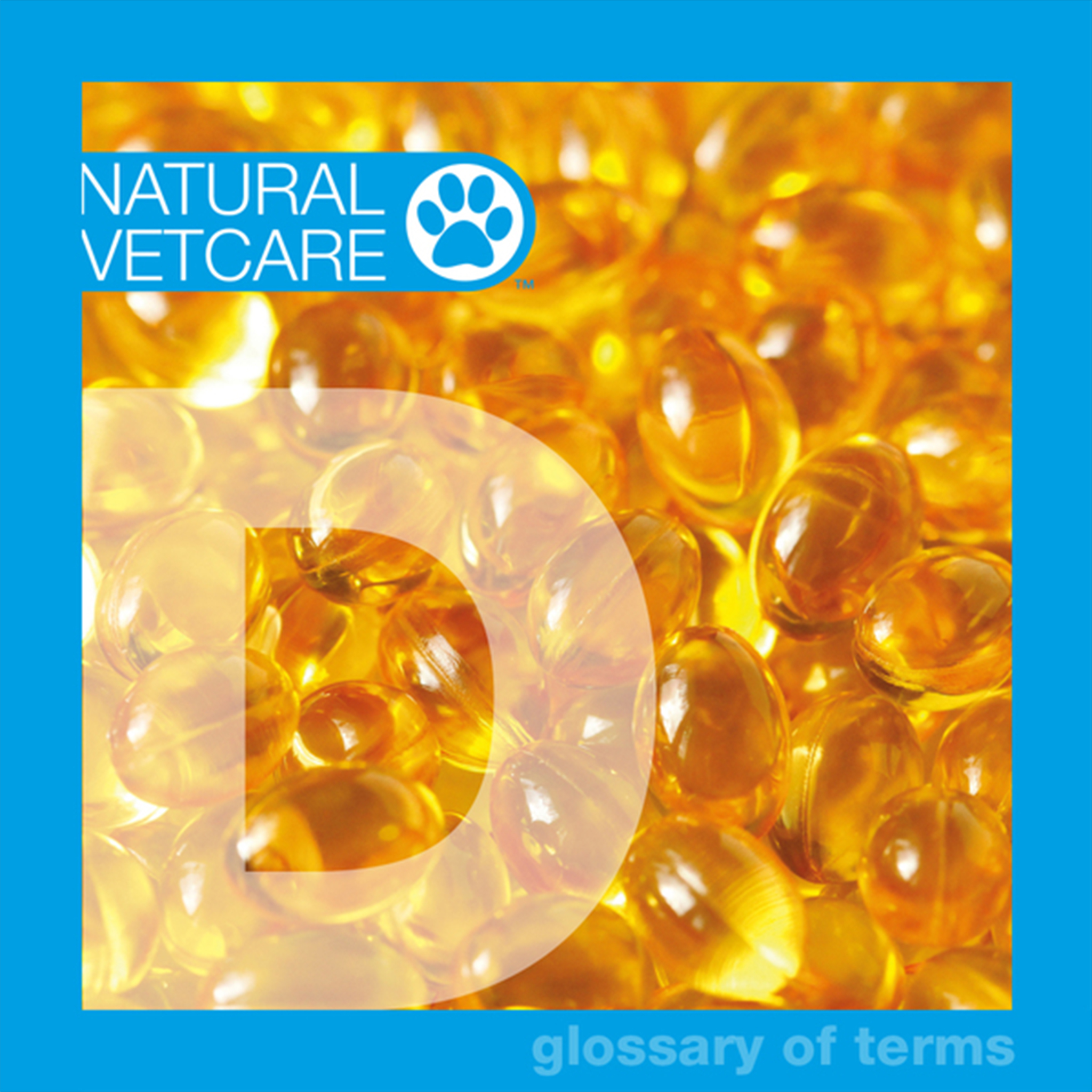
D is for Vitamin D.
Vitamin D covers a group of fat-soluble vitamins, with a range of important roles within the body. Often known as the 'sunshine vitamin', as we get most of our Vitamin D from absorption from the UV light of the sun, the situation is a little different in our dogs and cats. In pet health, their natural prey food provides good levels of Vitamin D, to the extent that they have now evolved to only poorly utilise the sun's UV source. Therefore, dogs and cats must receive Vitamin D in their diet, and this often needs to be added to pet food in order to ensure sufficient levels are received.
Within the system, Vitamin D has an important role in optimising calcium and phosphorous absorption, and a deficiency of D can be seen as skeletal issues such as rickets and growth abnormalities. Not just bone health though, vitamin D also plays a significant role in skin and hair health. A recent trial investigated the role of Vitamin D in Atopic Dermatitis in dogs, compared to a placebo. The results clearly showed the dogs had lower pruritis (itching) and lesion scores when on the Vitamin D supplement compared to the placebo.
However, nature is a vastly complex thing, and we find no single ingredient is ever the answer to your dog or catâs health. There are certainly dangers associated with looking for a 'pure' Vitamin D for your pet, as excess levels can be toxic. Instead, look for a synergistic blend which combines the action of Vitamin D, with the antioxidant vitamins A, E, the B vitamins, particularly Biotin, MSM for sulphur donation with omega three fatty acids for all round skin nourishment.
Selected Reference:
1. Klinger C.J et al (2018) Vitamin D, shows in vivo efficacy in a placebo-controlled, double-blinded, randomised clinical trial on canine atopic dermatitis. Veterinary Record. Apr 7, 182 (14) 406.
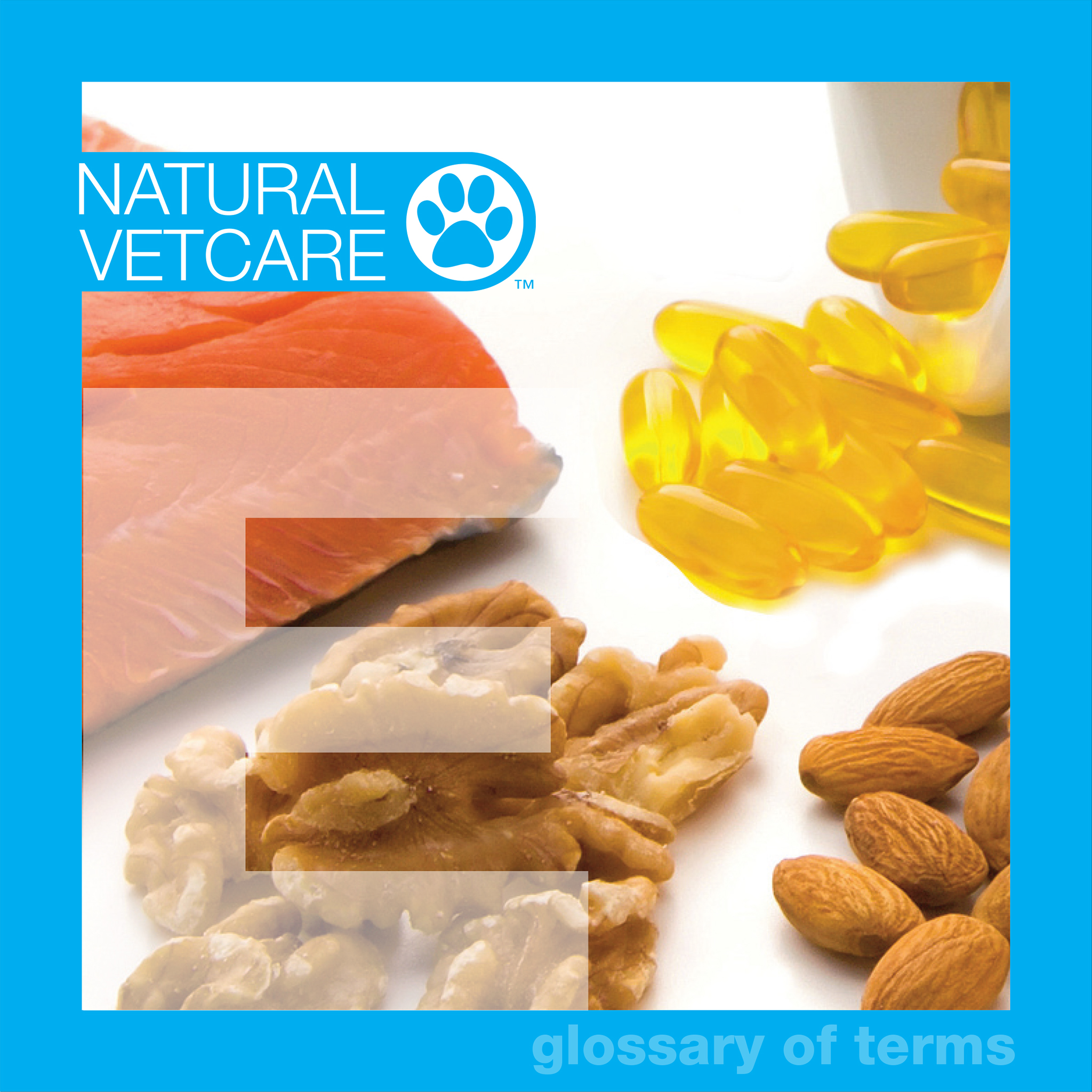
E is for Essential Fatty Acids.
Essential Fatty Acids, known as EFAs, which are those lipids, or fats, required in the diet as the animal themselves cannot manufacture them. For dogs and cats there are two types of EFAs, which are classified by their structure, and known as Omega 3 fatty acids and Omega 6, and they both have essential roles to play in companion animal health.
The Omega 6 Fatty Acids for dogs and cats are linoleic acid (LA) and arachidonic acid (AA). LA is essential to both dogs and cats, while AA is only essential to cats, so showing another little difference between the two species. A deficiency of omega 6 is seen as poor skin and coat condition, and general poor vitality.
The key Omega 3 Fatty Acids are alpha-linolenic acid (ALA), eicosapentaenoic acid (EPA) and docasaheaenoic acid (DHA), with EPA and DHA being the most effective forms. Omega 3s support the bodyâs own anti-inflammatory system, meaning a deficiency may be seen as an increase in inflammatory responses. Omega 3s are also recognised in other areas including mental acuity, anti-ageing and optical health.
EPA and DHA are mainly found in marine sources, such as fish oil, but also in the natural food of the sea, the plankton, such as chlorella. Both the Omega 3, LA and Omega 6, ALA can also be found in plant sources, including soya and linseed oil.
Supplementing with Omega 3 and 6 in a balanced ratio is recommended for all dogs and cats, to support a calm, healthy skin response, mental acuity and general vitality.
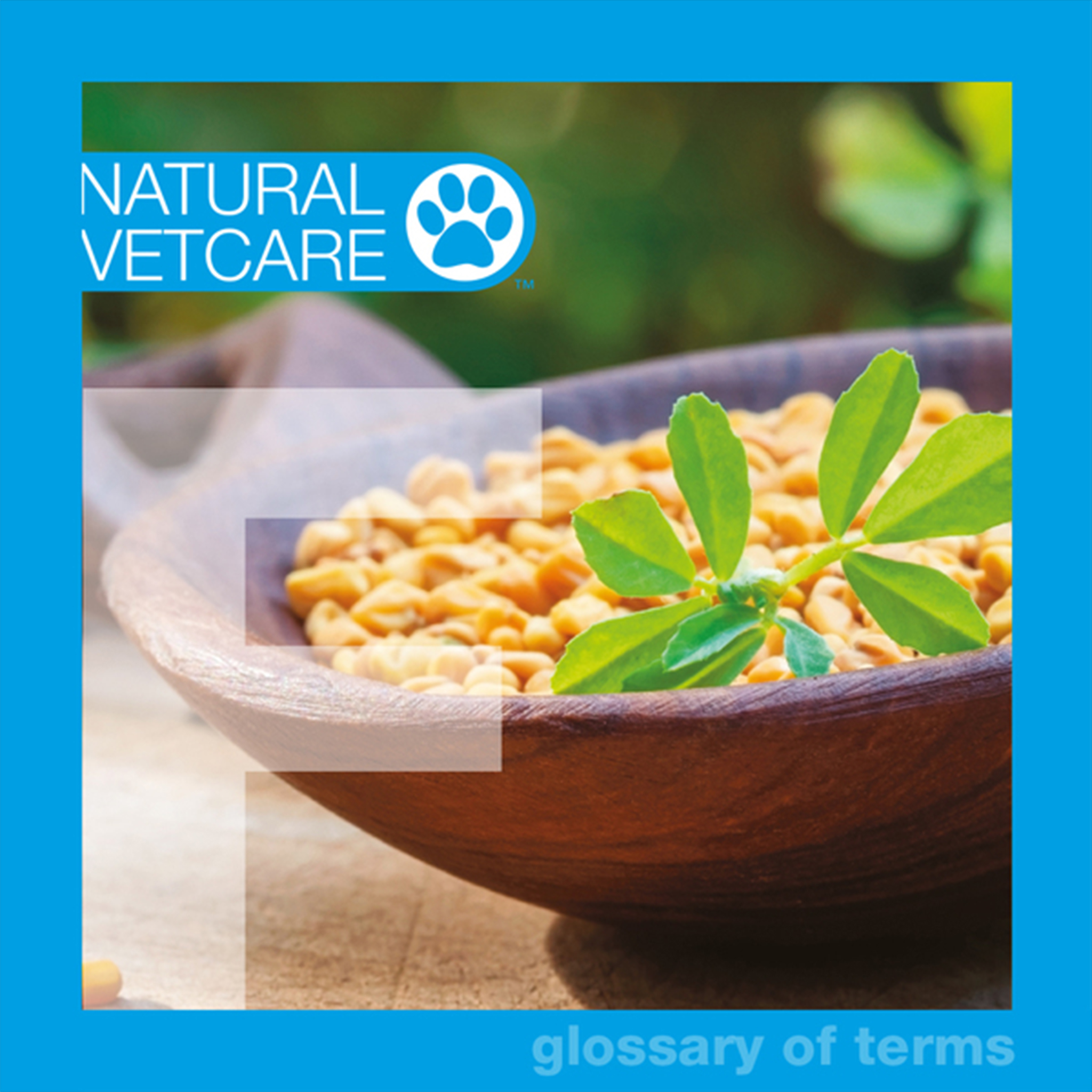
F is for Fenugreek.
Fenugreek is widely used in traditional herbal remedies, with a long history. Fenugreek seeds were even found in pharaohâs tombs, including Tutankhumn's, where it is believed they were placed to ensure a long and healthy after-life! Fenugreek is also widely used in cookery in it's native Mediterranean, southern Europe and Asia.
Strongly antioxidant, the benefits of fenugreek have been researched in a wide range of areas, with interest ranging from diabetes to anti-cancer, to hormonal balance, including issues such as premenstrual tension.
Skin health is a particular area where the benefits of fenugreek, and it's active constituents, have been demonstrated; and we recommend it's use as part of a synergistic nutritional formula.
Selected References:
1. Kawabata T et al (2011) Anti-inflammatory and anti-melanogenic steroidal saponin glycosides from Fenugreek seeds. Planta Medica 77(7) 705-10
2. Ktari N et al (2017) Antioxidant and haemolytic activities, and effects in cutaneous wound healing of a novel polysaccharide from fenugreek seeds. International Journal of Biological Macromolecules. 95: 625-634
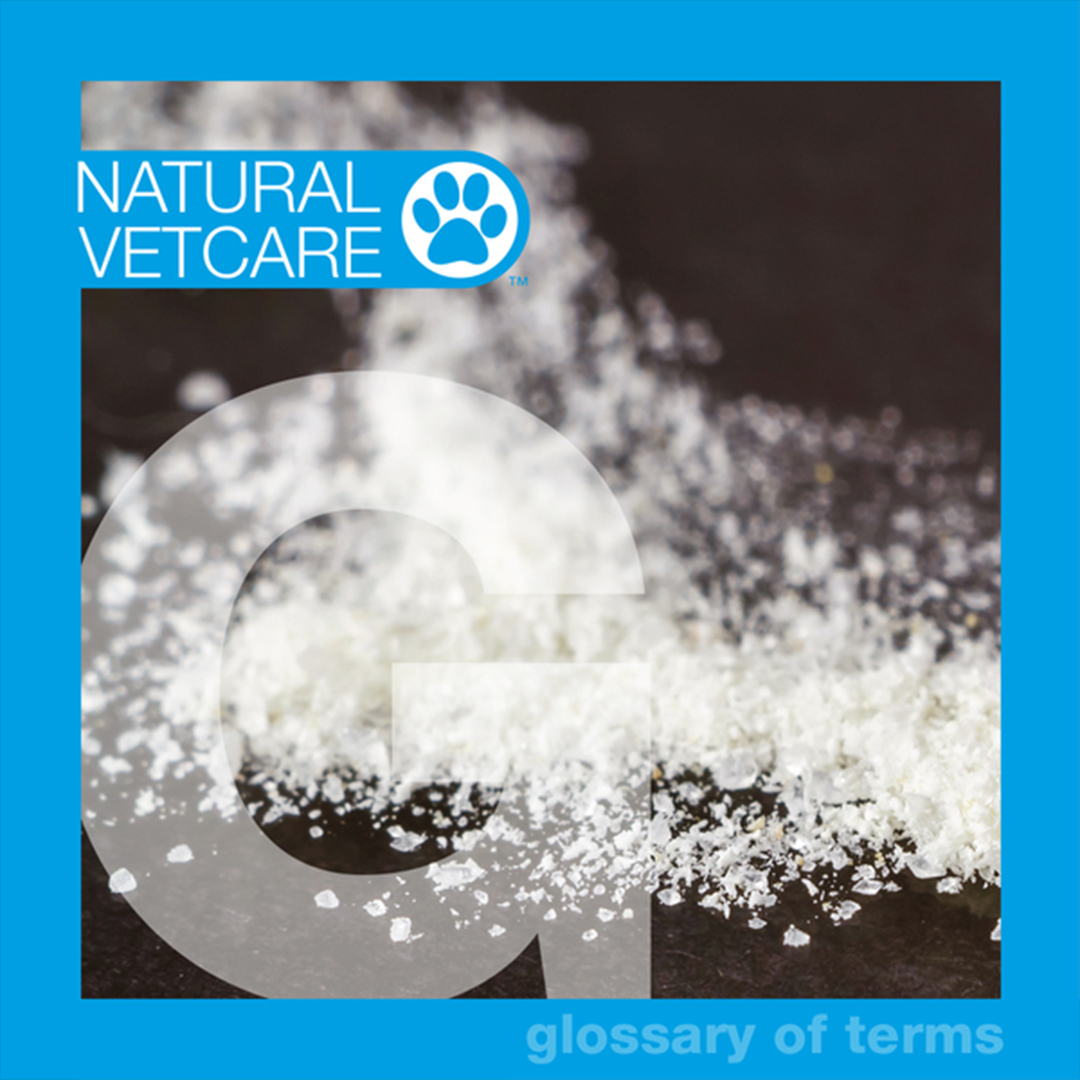
G is for Glucosamine.
Glucosamine is, perhaps, one of the best known ingredients in health supplements, as it is commonly utilised in joint support products for ourselves, our horses and dogs. Glucosamine is a specialised amino sugar, not to be confused with simple sugars, glucosamine is safe and suitable for all horses and ponies. Glucosamine is a precursor of glycosaminoglycans (GAGs), the major building blocks of joint structures such as cartilage and synovial fluid, hence it's important role in maintaining joint health.
It is important to recognise that not all glucosamines are equal, and the type is very important to it's efficacy. There are three commonly available forms, being Glucosamine hydrochloride (HCl), n-acetyl Glucosamine and Glucosamine sulphate, and when the extensive body of research is reviewed, only the sulphate form has sufficient evidence to officially support itâs use. Not just in people, the greater efficacy of Glucosamine sulphate over the HCl form has also been shown in equine trials. Therefore for effective support, ensure the product you are using lists Glucosamine sulphate on the label.
Of course, nature is very complex, and no one ingredient works on it's own. For ultimate flexibility in all horses, ponies and dogs look for synergistic blends of Glucosamine sulphate working alongside other joint nourishment ingredients including MSM, Chondroitin sulphate, H.A, Antioxidants and Omega 3 fatty acids, such as NAF Five Star Superflex or Superflex Senior.
Selected References:
1. Glucosamine sulphate. Medline Plus, US National Library of Medicines. 17 June 2019. https://medlineplus.gov/druginfo/natural/807.html
2. Meulyzer M et al (2008) Comparison of pharmacokinetics of glucosamine and synovial fluid levels following administration of glucosamine sulphate or glucosamine hydrochloride. Osteoarthritis and Cartilage 16, 973-979
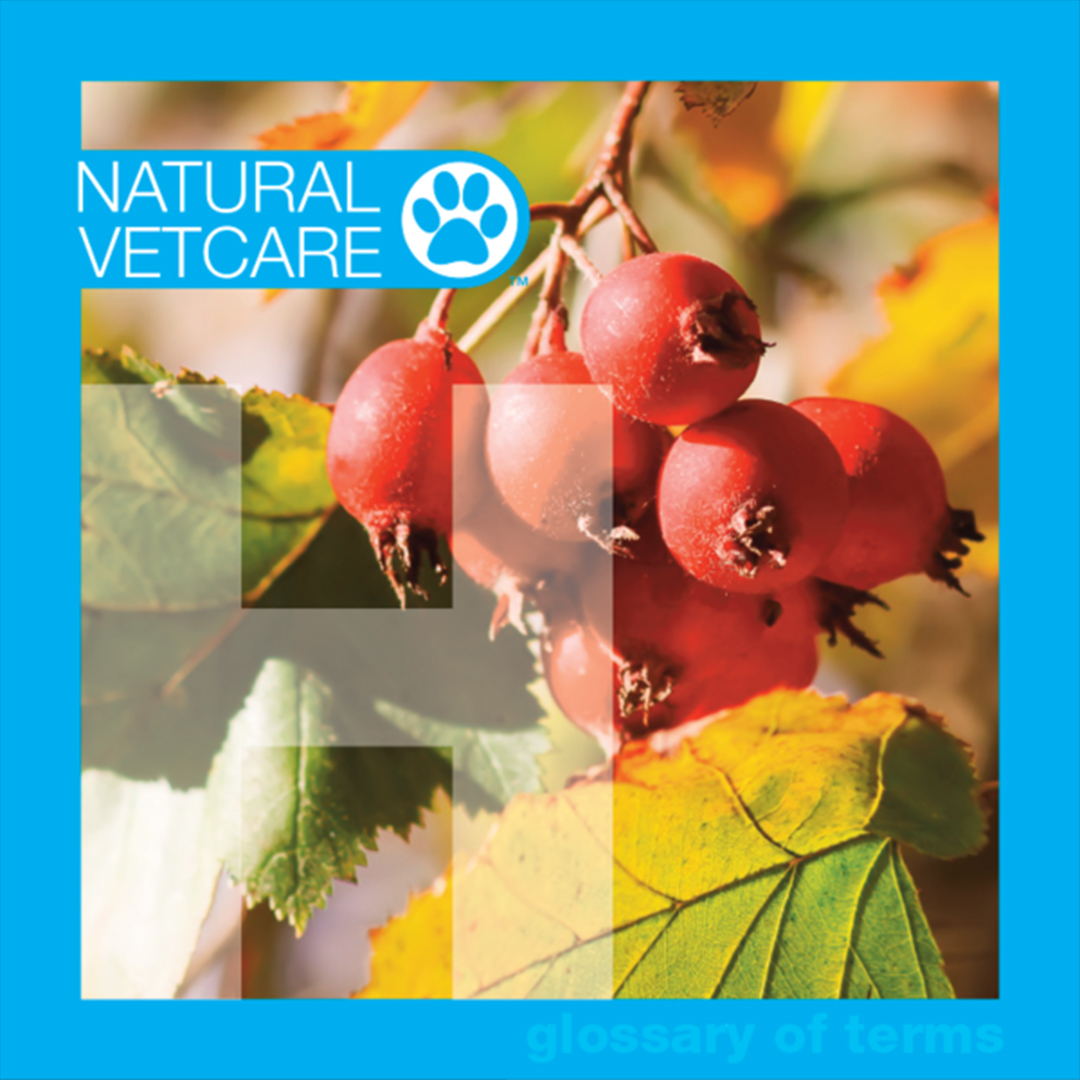
H is for Hawthorn Berries.
Hawthorn berries are a common sight in our native British hedgerows but can provide us with much more than just winter colour. The use of hawthorn in traditional remedies is widespread, with one of its best known benefits being in heart health.
A large review paper of 2008 looked at results from over 850 patients and found hawthorn for heart health to be significantly more beneficial than the placebo. Heart disease is a common condition of older dogs, and research supports helping the dog at an early, asymptomatic, stage. However, the drugs available are costly and can produce side effects, so itâs good to see hawthorn being researched as a suitable alternative.
Very recent research in dogs with diseased heart valves found an extract of hawthorn to be beneficial for heart health and keeping clinical signs of disease at bay for longer, so making it a great choice for a healthy heart in older dogs.
Selected References:
1. Balbueno MC, Peixoto KDC Jnr & Coelho CP (2020) Evaluation of the efficacy of Crataegus ocyacantha in dogs with early-stage heart failure. Homeopathy. doi: 10.1055/s-0040-1710021. Online ahead of print.
2. Pittler MH, Guo R & Ernst E (2008) Hawthorn extract for treating chronic heart failure. Cochrane Database of Systemic Reviews. Jan 23(1)
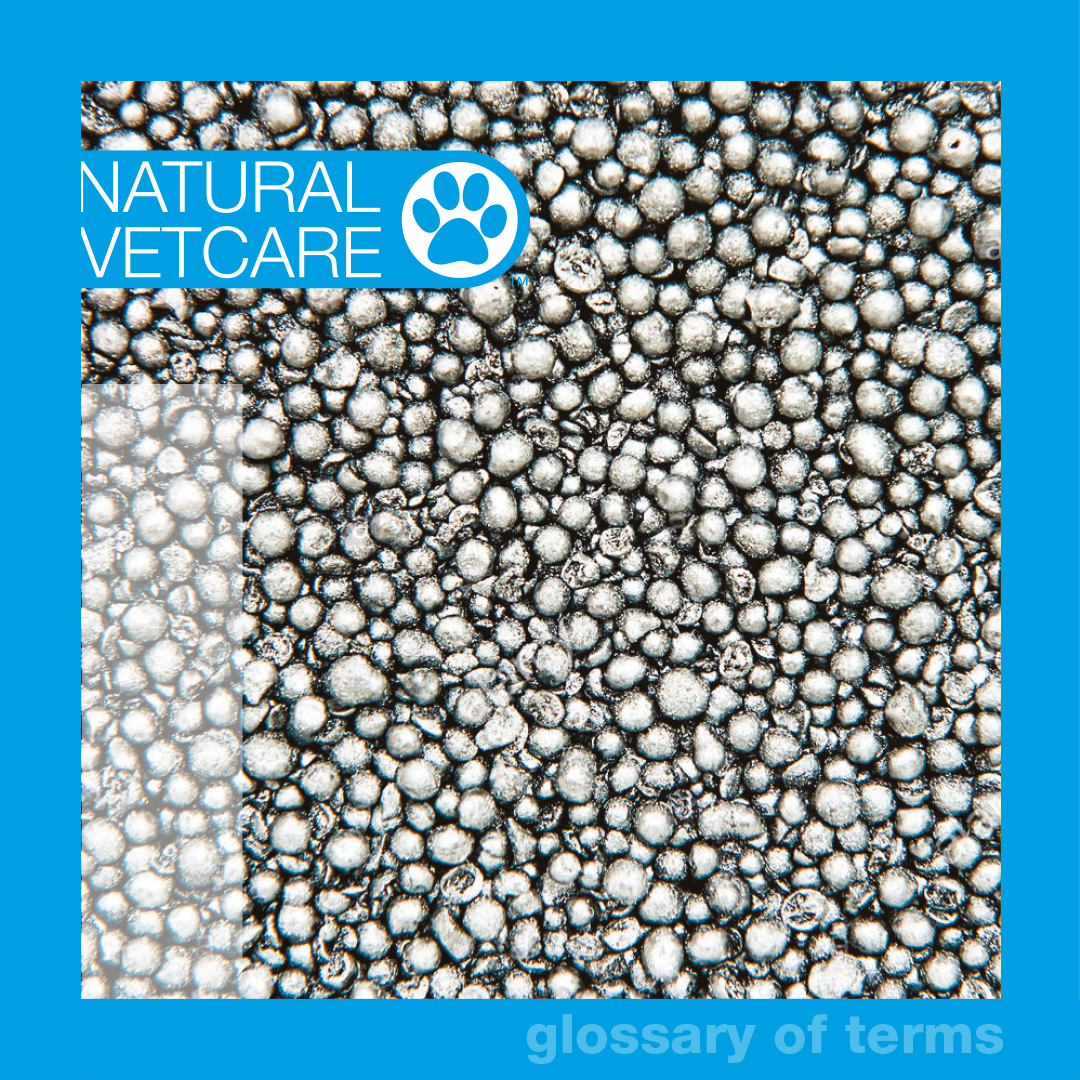
I is for Iodine.
Iodine is an important nutrient for health and vitality. However it is required in tiny amounts, and it is important the correct balance is maintained, particularly for cats. Therefore, although this A-Z series usually highlights ingredients we do want, this time weâre talking about an ingredient where caution is advised.
The majority of the bodyâs iodine is held in the thyroid gland, where it is converted to the hormones thyroxine and triiodothyronine. When the balance of hormones is upset, we see clinical changes. Hyperthyroidism, from excess iodine, results in higher circulating thyroxine, and is common in older cats being seen in approximately 10% of cats over 11 years old.
Signs of hyperthyroidism in cats include unexplained weight loss, restlessness, increased vocalisation and always being hungry! If this is your cat, your next step would be to ask your vet, for a diagnostic blood test. If detected, one of the simplest approaches is to feed an iodine-restricted diet. Suitable cat food is available, and you should avoid rich sources in their diet, such as seafood.
When supplementing the diet, it is important to ensure that the product balances and supports the ideal ratios and does not over-supply key nutrients. Therefore, where iodine is concerned, we ensure we use no added iodine, and low background levels, to avoid disrupting the natural balance in our cat products.
Contact us to discuss targeted nutritional support for older cats, including hyperthyroid cats.
Selected References:
1. Sordo L et al (2020) Prevalence of Disease and Age-related Behavioural Changes in Cats: Past and Present. Veterinary Sciences. 7, 85; doi:10.3390/vetsci7030085
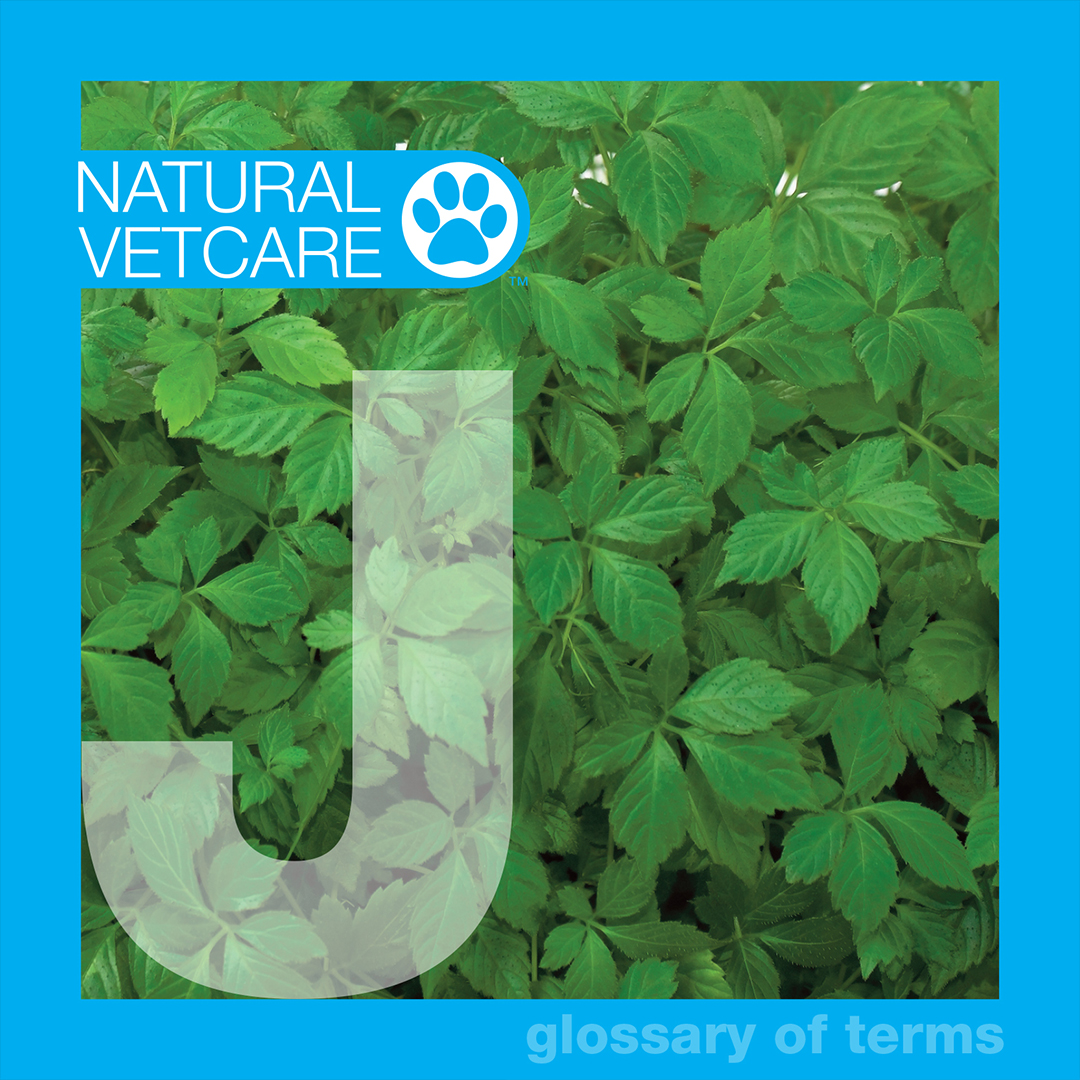
J is for Jiaogulan.
Jiaogulan is a beneficial herb native to South and East Asia, which goes under many other names, including Gynostemma and Poor Man's Ginseng. It earned one of itâs better known names, that of 'Immortality Herb', when a Chinese census revealed a large number of very elderly people in it's native Guizhou province reported taking it regularly. Jiaogulan is one of the 'adaptogen 'herbal supplements that help the body adapt to physiological stress. Adaptogens are so named as they are used to both help athletes adapt to the demands of peak performance, but also help people and animals adapt to physical challenges of ageing.
Research in Jiaogulan identifies a number of areas of interest, in particular with respect to metabolism and antidiabetic roles, though research in immune support and even anti-cancer studies are also encouraging. In horses, our own internal field trials show Jiaogulan plays a role within a herbal complex for maintaining the health of the pituitary gland.
Selected References:
Mishra R.N & Joshi D (2011) Jiao Gu Lan: The Chinese Rasayan â Current Research. Int. Jn of Research in Pharmaceutical and Biomedical Sciences. Vol 2(4) p1483-1502
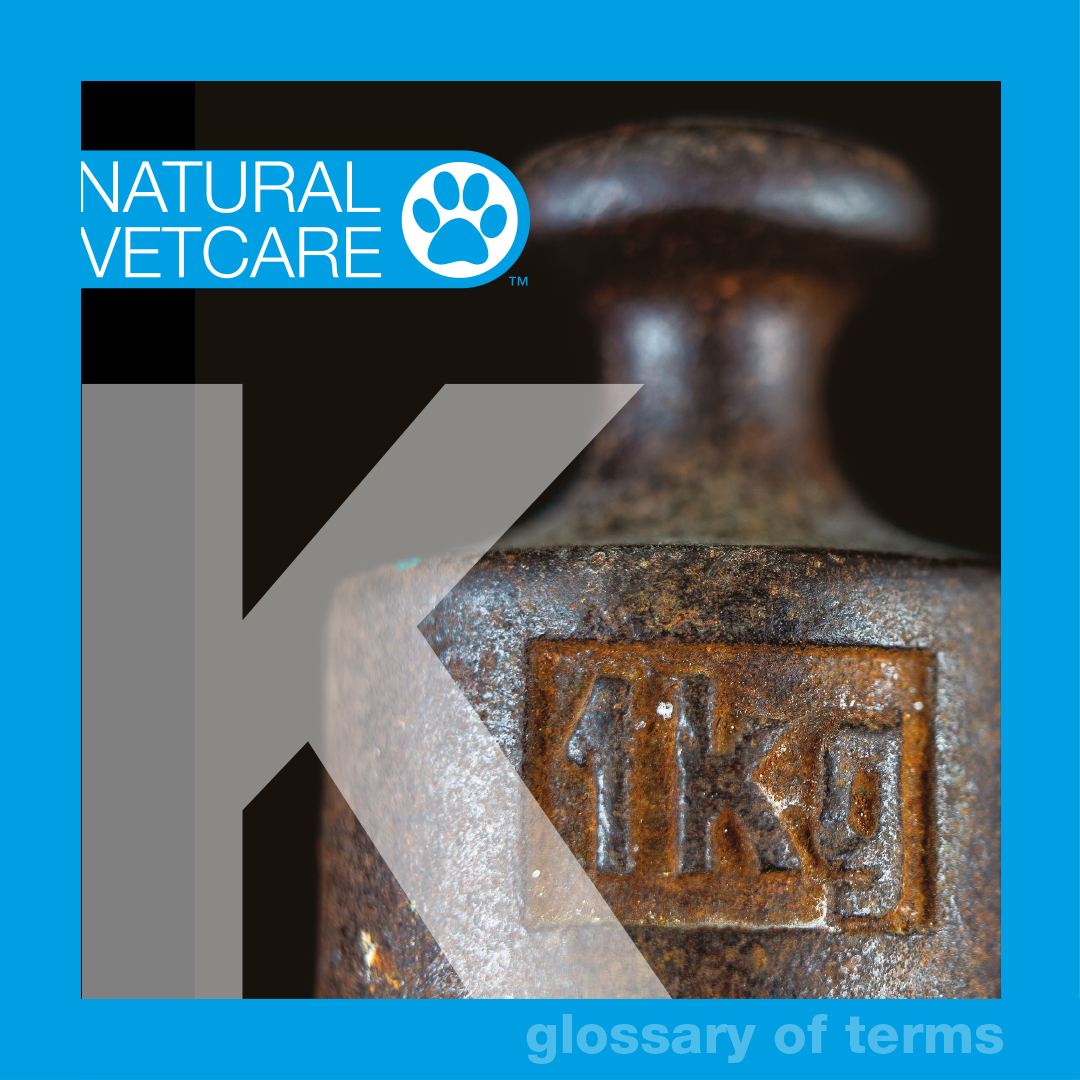
K is for Kilogram.
Kilogram, the unit of mass from the International System of Units (SI system), is used as an industry standard on animal feed and pet food labelling. For most label declarations the inclusion or essential nutrients such as Vitamins, Trace Elements or Amino Acids will be per kilogram (per kg), or per litre (per l) for liquid products.
If you want to know how much your dog or cat is receiving always adjust the kilogram rate to the daily feeding rate, or look for 'Key Ingredients per Scoop' on some labels.
A kilogram was originally defined, in 1795, as the mass of one litre of water. However, there were errors with this system, so was replaced by a small cylinder of platinum and iridium closely guarded in a Parisian vault. These days, the international standard is defined by an updated mathematical formula.
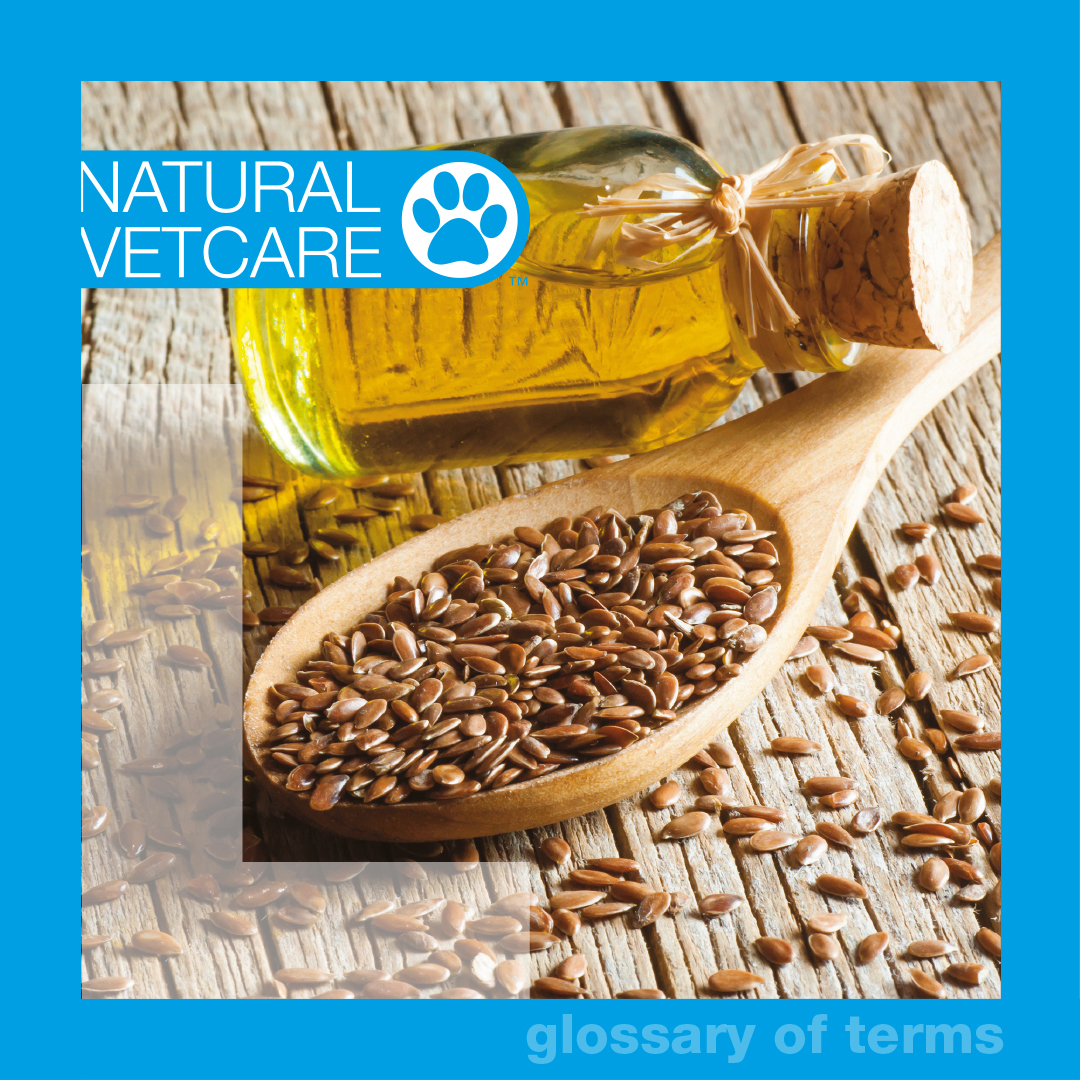
L is for Linseed Oil.
Linseed oil comes from the flax plant, which has been used for thousands of years to make the textile linen. The seeds are small and nutty tasting and have even been found in an Egyptian tomb! When pressed into an oil it becomes a rich source of essential amino acids, especially the amazing omega-3 fatty acids, alpha-linolenic acid in particular. You will see linseed oil also referred to as flaxseed oil.
The essential fatty acids are termed 'essential' due to the fact the dogs cannot produce them themselves and must obtain them from their diet. Omega-3 fatty acids are vital for a healthy skin and coat, as well as joint health, immune function, wound healing and brain development. Studies have shown that supplementing with essential fatty acids can improve haircoat and skin quality plus they can improve the skin barrier in dogs suffering from atopic dermatitis, a common allergic skin disorder that results in itchy and uncomfortable dogs. Combining linseed oil with a fish oil produces a well-rounded essential fatty acid supplement, while adding zinc and vitamin B6 improves palatability.
Selected References:
1. Combarros et al (2020) 'A prospective, randomized, double-blind, placebo-controlled evaluation of the effects of an n-3 essential fatty acids supplement on clinical signs, and fatty acid concentrations in the erythrocyte membrane, hair shafts and skin surface of dogs with poor quality coats' Prostaglandins, Leukotrienes and Essential Fatty Acids 159 pp. 1-6
2. Popa et al (2011) 'Analysis of epidermal lipids in normal and atopic dogs, before and after administration of an oral omega-6/omega-3 fatty acid feed supplement. A pilot study' Veterinary Research Communications 35 pp. 501-509
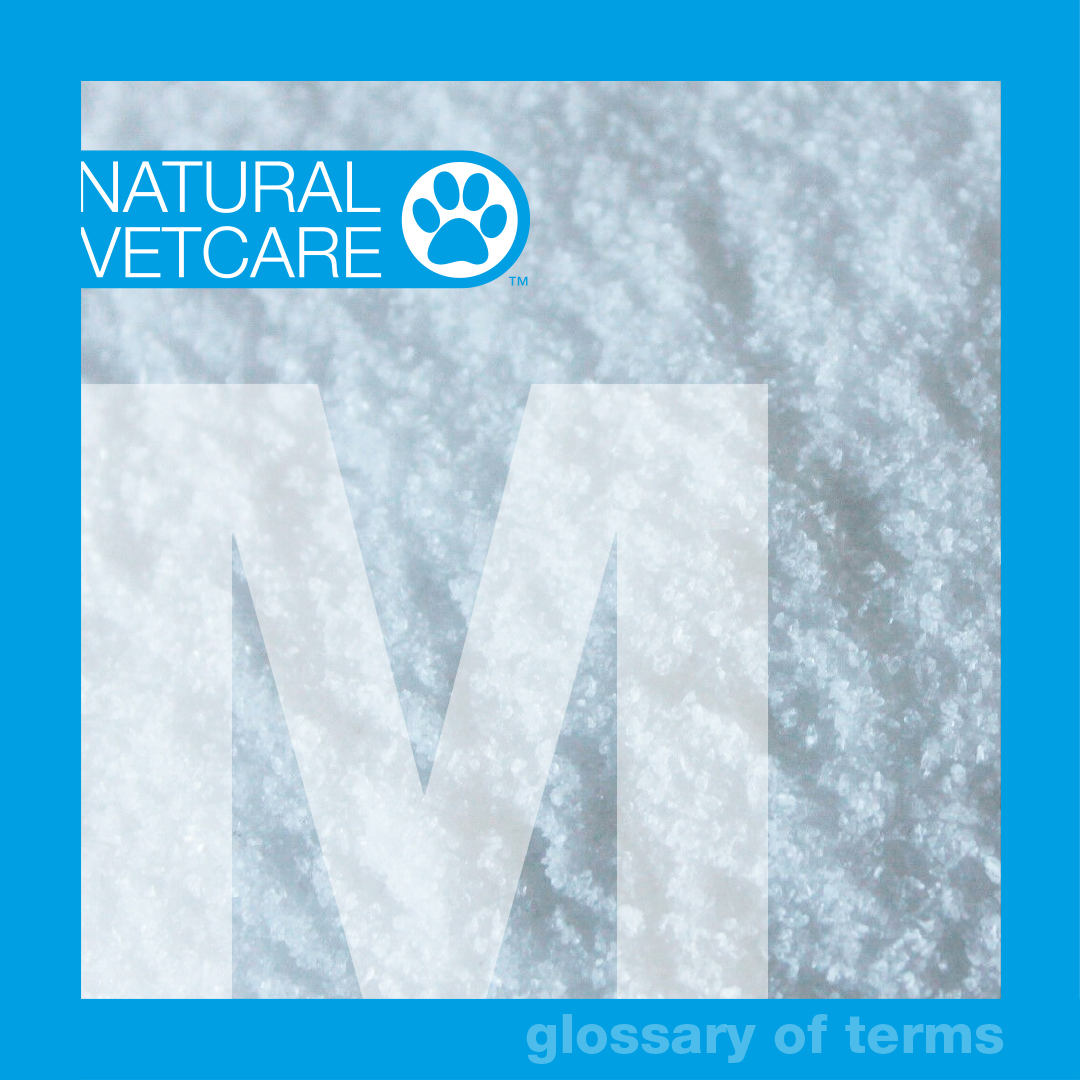
M is for MSM
Methyl sulphonyl methane, or MSM, is an organosulphur compound containing 34% sulphur, making it one of the most sulphur-rich compounds in the diet. Sulphur is an important precursor to the amino acids methionine and cysteine. Methionine and cysteine are both vital in forming molecules critical for normal cell function, growth and repair.
MSM has been reported to have anti-inflammatory, analgesic, anti-allergic and antioxidant properties. It also acts synergistically with most vitamins and other nutrients, assisting their uptake into the cell. MSM is mostly known for its joint health benefits but also has potential benefits in other situations involving inflammation, cancer, autoimmune and allergic responses.
NAF have been using MSM in their equine products for 30 years, now itâs our dogs' and cats' turn to benefit from this super sulphur!
Selected References:
1. Butawan M, Benjamin R.L & Bloomer R.J (2017) 'Methylsulfonymethane: Applications and safety of a novel dietary supplement' Nutrients 9 (3) p290
2. EBSCO CAM Review Board (2019) 'Methylsulfonyl methane's therapeutic uses' Salem Press Encylopedia of Health
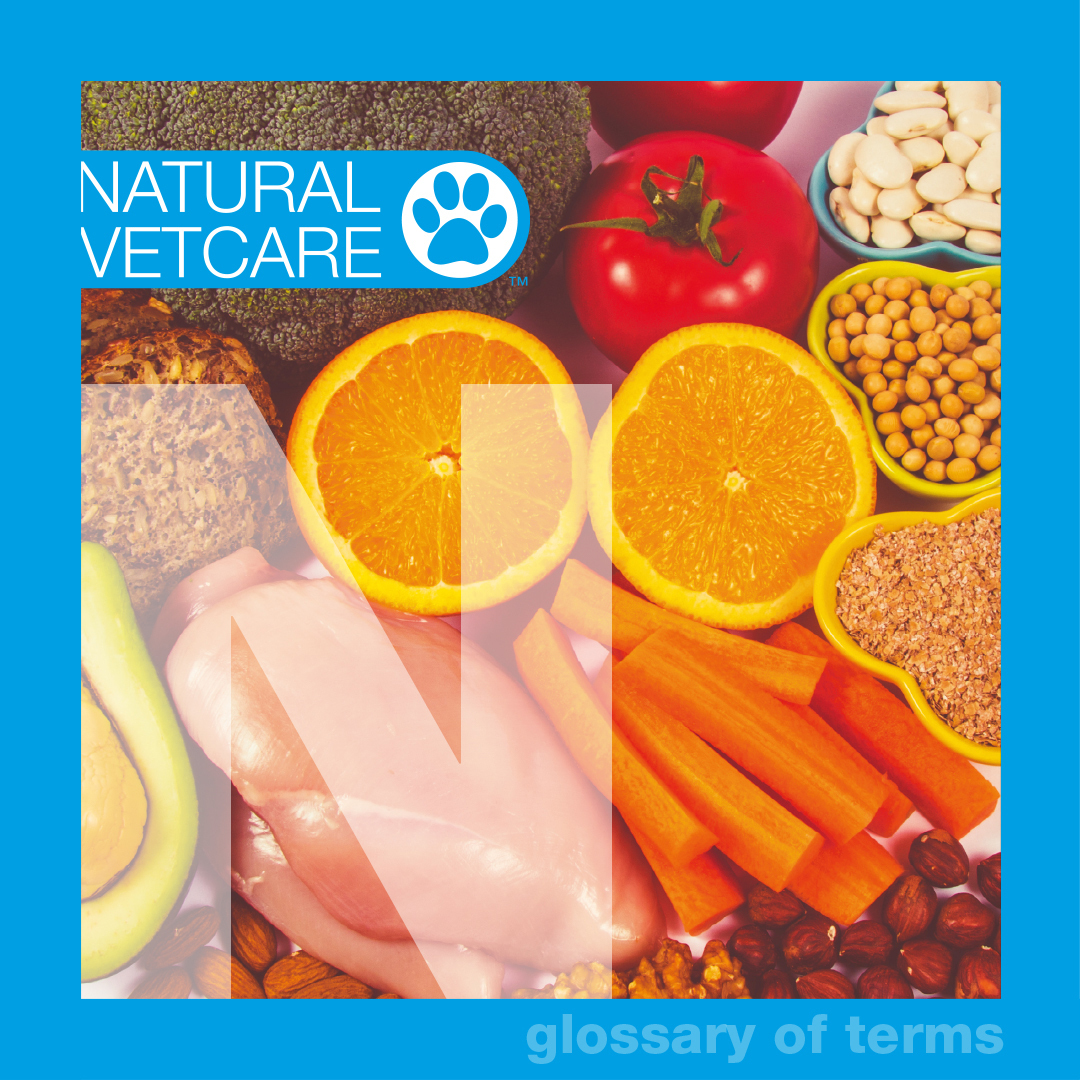
N is for Niacinamide
Niacinamide is sometimes known as nicotinamide, a water soluble form of vitamin B3, or niacin. Niacinamide is important for many enzyme reactions within the animal's body. Niacinamide plays an important role in the metabolism of proteins, fats and carbohydrates as well as being needed for the formation of sex hormones and important chemical signaling molecules.
Niacinamide is needed for healthy skin, circulation, nervous system and metabolism. It can be used in treatment protocols for auto-immune skin disease in dogs and is used to lower cholesterol in humans.
Dogs can make niacinamide from the amino acid tryptophan however cats cannot do this and must be supplied with adequate levels of niacinamide in their diet. For this reason, most commercial pet foods are fortified with niacinamide. Deficiency can occasionally be seen in animals on high-corn cereal diets as plant-sources contain a bound form that is poorly available, resulting in a condition known as 'black tongue' or 'pellagra'.
Selected References:
1. Combarros et al (2020) 'A prospective, randomized, double-blind, placebo-controlled evaluation of the effects of an n-3 essential fatty acids supplement on clinical signs, and fatty acid concentrations in the erythrocyte membrane, hair shafts and skin surface of dogs with poor quality coats' Prostaglandins, Leukotrienes and Essential Fatty Acids 159 pp. 1-6
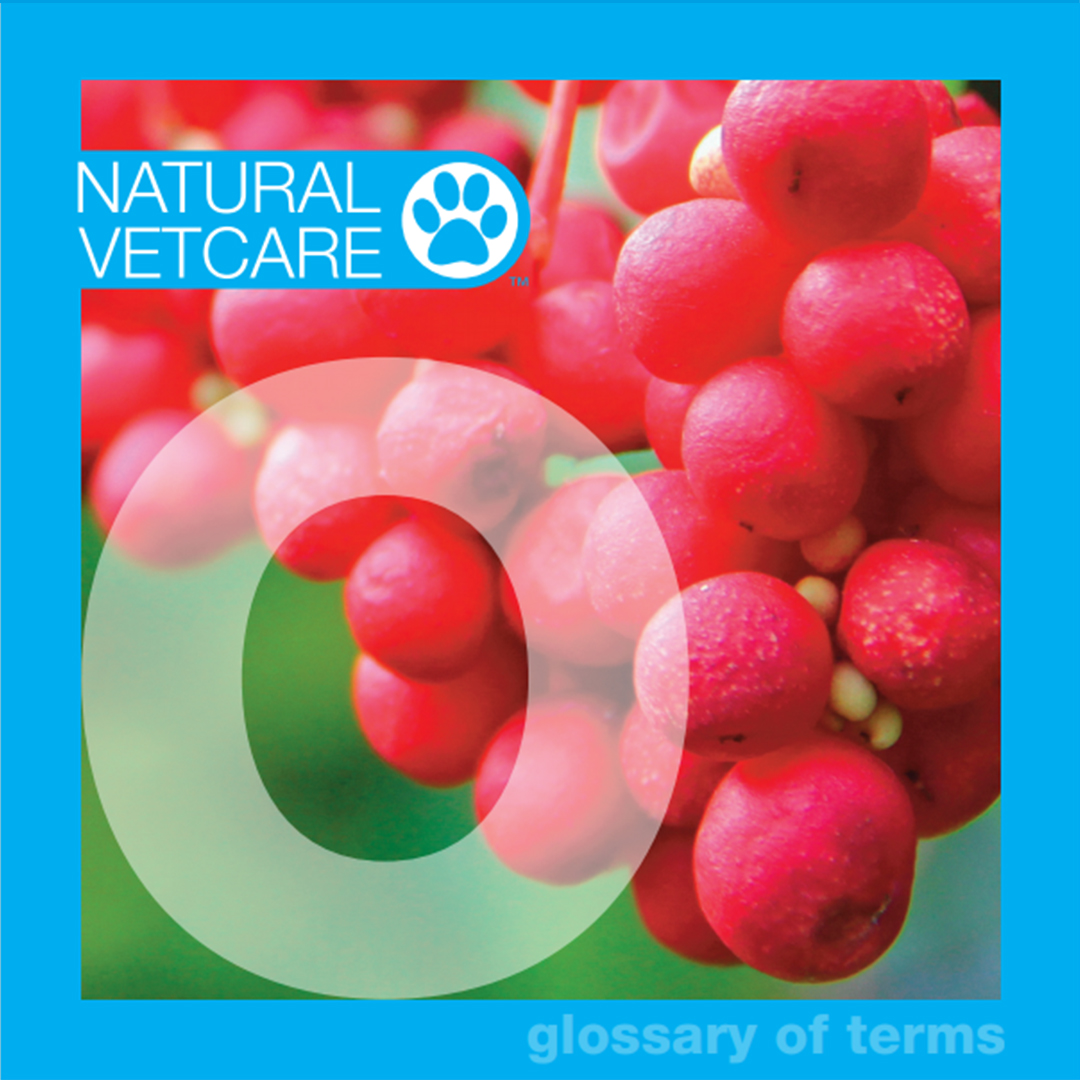
O is for Omicha.
Omicha (Omija, schisandra, schizandra, magnolia berry). Omicha in Korean means 'five flavour berries' because they give five different flavours - sour, sweet, bitter, pungent and salty. These super-powered berries are native to North Eastern China, Korea and parts of Siberia. They have been used in traditional Chinese medicine for many years to improve kidney and liver function, blood circulation, increase resistance to disease and stress and to improve skin and mental performance. They are often made into a tea, fruit punch or taken in supplement form.
Omicha berries are 'adaptogens' these are a group of herbs that support the bodyâs natural ability to deal with stress and 'adapt' their function according to the body's specific individual needs. They have strong antioxidant and anti-inflammatory affects and can have beneficial effects on virtually all of the body's systems - the central nervous, sympathetic, endocrine, immune, respiratory, cardiovascular and gastrointestinal systems. Omicha berries have been subject to many pharmacological studies over the years so there is a lot of evidence for their wide ranging beneficial effects.
Selected References:
1. Panossian & Wikman (2009) 'Pharmacology of Schisandra chinensis bail.: An overview of Russian research and uses in medicine' Journal of Ethnopharmacology 118(2) pp. 183-212
2. Panossian & Wikman (2010) 'Effects of adaptogens on the central nervous system and the molecular mechanisms associated with their stress-protective activity' Pharmaceuticals (Basel) 3(1) pp. 188-244
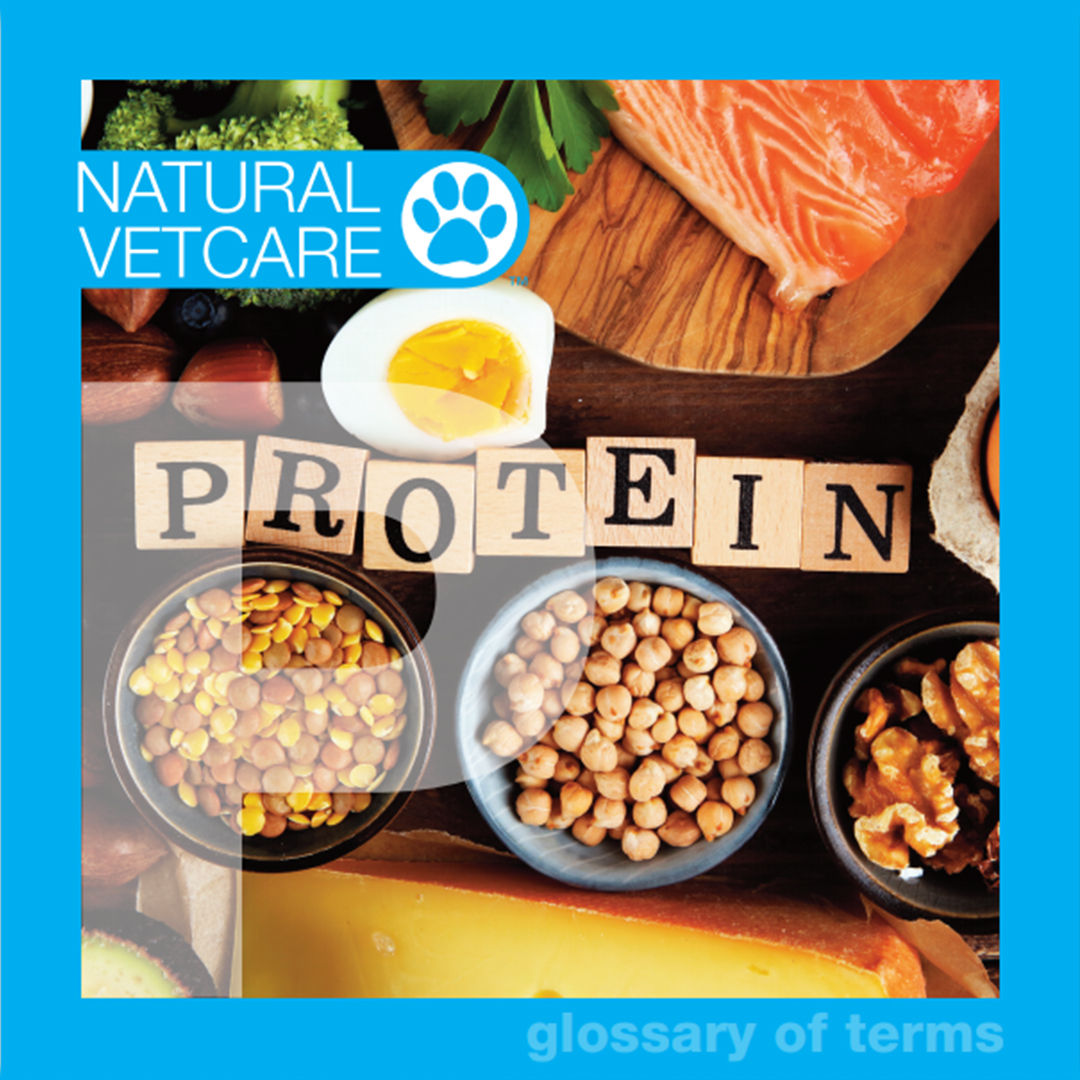
P is for Protein.
We have all heard of protein but do you know what is it?
Protein molecules are large complex structures made up of building blocks of nitrogen-containing amino acids. There are about 20 different naturally occurring amino acids that combine in many different ways to produce many different proteins that all have different functions, from enzymes and hormones to providing the structure for muscle, skin and nails. Proteins are species and organ specific, each has their own very specialized role to play, without them life could simply not exist.
Plants can synthesise all of the amino acids but animals cannot. Those that they cannot make themselves are termed âessentialâ and are required in the diet. Dogs need 10 essential amino acids in their diet, including methionine and tryptophan. 11 essential amino acids are required in a cat's diet as they also require taurine. Taurine is only found in animal tissue making cats obligate carnivores, i.e. they must eat meat.
Supplement labels are legally required to state protein levels. This can mislead you into thinking it is 'high protein' but remember, once feeding rate is factored in, it will form only a small part of the animalâs daily intake.
Selected References:
1. Haurowitz F. (2020) 'Protein' Encyclopedia Brittanica www.britannica.com/science/protein
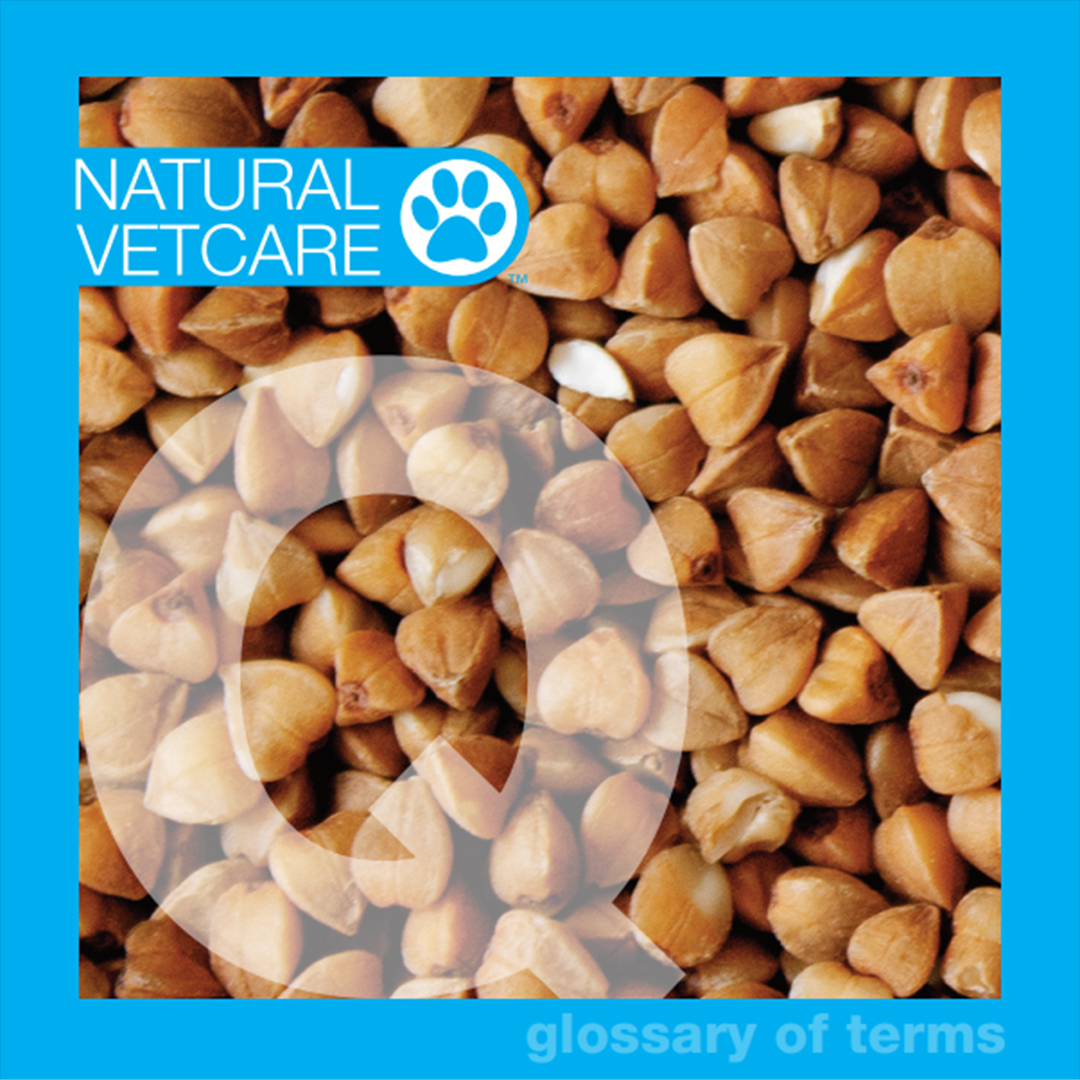
Q is for Quercetin.
One of the unique phtytochemicals that make up the large and diverse group of antioxidants, also known as natural flavonoids. Quercetin is found in many fruits and vegetables, including cherries, citrus fruits and dark green vegetables such as kale. Particularly rich sources include the allium group such as onions and - commonly found in equine nutrition - garlic.
Through it's antioxidant action, research has recognised the unique potential of quercetin in a number of different health challenges across species, from cancer to Covid. We should stress, that the potential link to our current global pandemic is purely theoretical at this stage, based on it's strong antioxidant action. However, history does show that garlic was beneficial at the time of The Great Plague, another pandemic respiratory disease, and we often see modern science eventually catching up with traditional phytotherapy uses.
You wonât see quercetin on feed and supplement labels, as it is an active constituent within the herb, rather than ingredient itself. However, look for naturally sourced antioxidants in targeted health support products for your horses, dogs, cats and poultry to feed the power of quercetin and other flavonoids.
Selected References:
1. D'Andrea G (2015) Quercetin: A flavonol with multifaceted therapeutic applications? Fitoterapia. Oct 106: 256-71
2. Khubber S et al (2020) Garlic (Allium sativum): a potential unique therapeutic food rich in organosulfur and flavonoid compounds to fight COVID-19. Nutrition Journal. 2020 19:124 Published online https://www.ncbi.nlm.nih.gov/pubmed/33208167
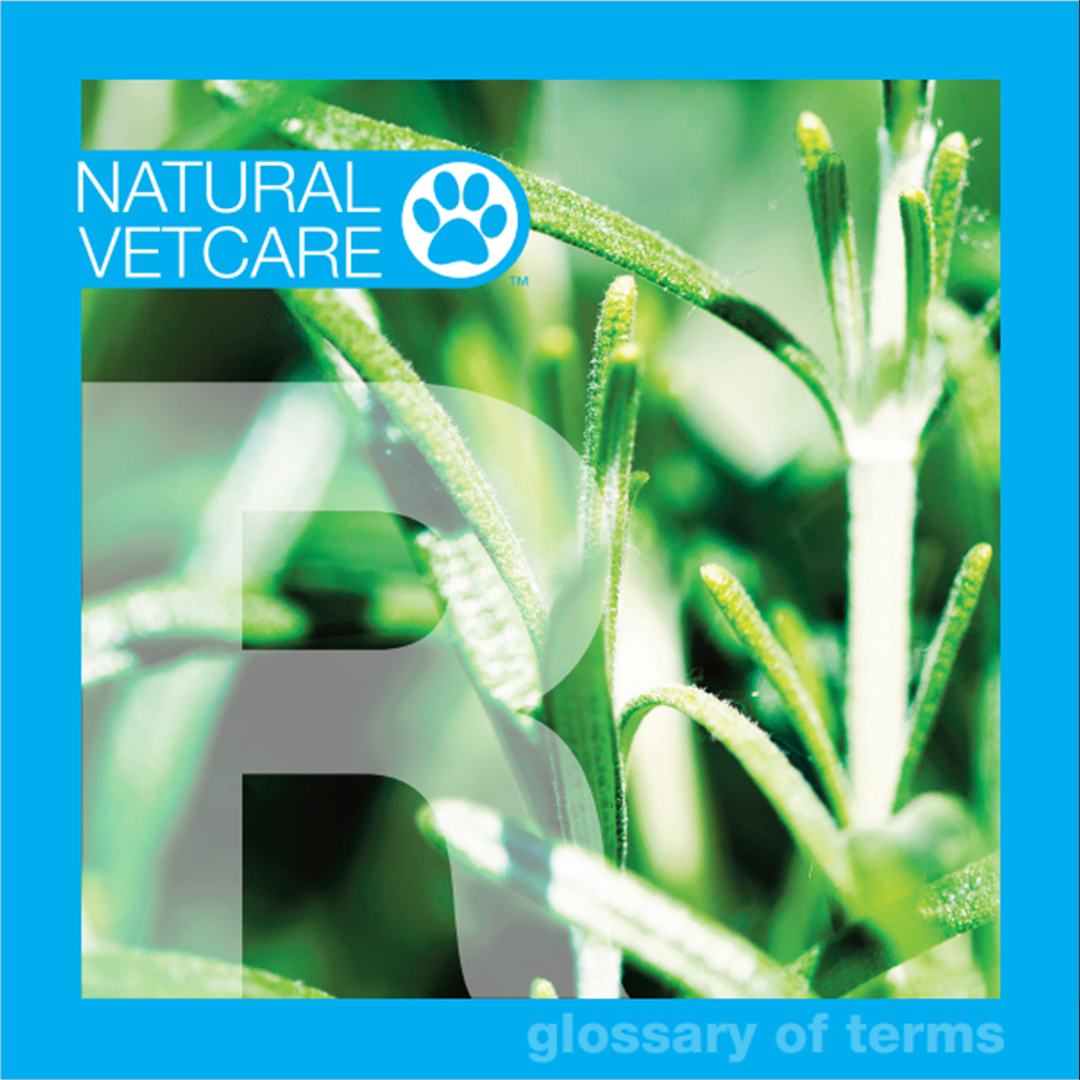
R is for Rosemary.
The name is derived from the Latin words 'ros' and 'marinus' meaning 'dew of the sea'. It is a Mediterranean shrub high in iron, calcium and vitamin B6, that has a long history of being used in traditional remedies, cooking and for food preservation. It is often used in pet food to mask flavours and as a natural barrier against food-borne bacteria and food spoilage.
Rosemary has powerful antimicrobial, antioxidant and anti-inflammatory properties. Studies have shown it is effective against various types of fungi and bacteria, including Staph aureus and E. coli, while its powerful antioxidant capabilities have been utilised in food preservation, protecting the food against oxidation. Oxidative stress and inflammation drive cancer progression therefore rosemary may also have a cancer-protective effect.
Rosemary strengthens the heart and reduces irregular heart patterns (arrhythmias). It is thought to act by improving the function of the cells lining the blood vessel walls, thereby improving blood flow, circulation and overall health. It also has beneficial effects on the digestive system, reducing indigestion, spasms, gas and gastrointestinal infections.
Selected References:
1. Chraibi et al (2020) 'Characterization, antioxidant, antimycobacterial, antimicrobial effects of Moroccan rosemary essential oil, and its synergistic antimicrobial potential with carvacrol' Journal of Advanced Pharmaceutical Technology & Research 11(1) pp. 25-29
2. Petiwala & Johnson (2015) 'Diterpenes from rosemary (Rosmarinus officinalis): Defining their potential for anti-cancer activity' Cancer Letters 367(2) pp. 93-102
3. Shoja et al (2015) 'The Evaluation of the Protective Effects of the Hydro-alcoholic Extract of Rosemary (Rosmarinus Officinalis L.) on Ventricular Arrhythmias in Rats' Majallah-i Dānishgāh-i Ulūm-i Pizishkī-i Bābul 17 (5) pp. 66-72
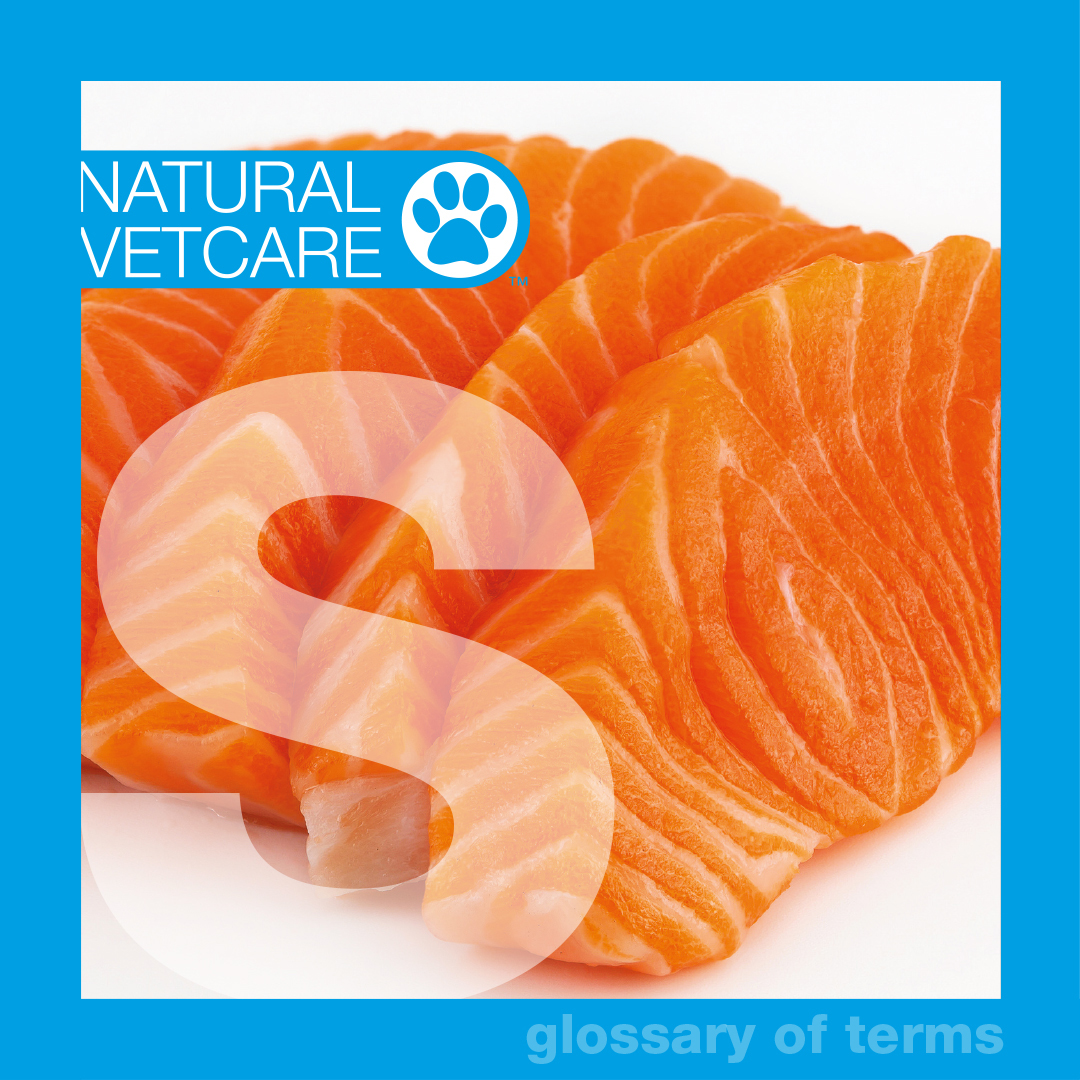
S is for Salmon oil.
Why does the NHS recommend we eat one portion of oily fish, such as salmon, once a week? It is because salmon oil is a rich source of the omega-3 fatty acids eicosapentaenoic acid (EPA) and docosahexaenoic acid (DHA).
EPA and DHA have been linked with reducing the risk of heart disease, improved brain health and reduced inflammation. High triglyceride levels are linked with heart disease and stroke, studies show that salmon oil reduces the bodyâs triglyceride level and can reduce the risk of heart disease if eaten 1-2 times weekly. DHA helps repair and maintain brain cells and so may reduce the risk of cognitive decline, and it is thought that the anti-inflammatory properties of salmon oil can protect against chronic inflammation-related diseases such as arthritis, diabetes and cancer. Studies have also shown omega-3 supplements reduce the risk of glaucoma and age-related vision loss.
You will often find salmon oil in skin supplements. This is because it contributes to healthy skin via it's anti-inflammatory effects. It reduces symptoms of dermatitis and promotes wound healing. One study has shown that supplementing dogs with EPA/DHA rich fish oil improved skin and coat quality with maximum improvements reached after 2 months, lasting for 1 month after stopping the supplement.
Selected References:
1. Combarros et al (2020) 'A prospective, randomized, double blind, placebo-controlled evaluation of the effects of an n-3 essential fatty acids supplement (Agepi® ω3) on clinical signs, and fatty acid concentrations in the erythrocyte membrane, hair shafts and skin surface of dogs with poor quality coats' Prostaglandins, Leukotrienes and Essential Fatty Acids 159
2. Swanson D., Block R., Mousa S.A. (2012) 'Omega-3 fatty acids EPA and DHA: Health benefits throughout life' Advances in Nutrition 3(1) p. 1-7
https://www.nhs.uk/live-well/eat-well/fish-and-shellfish-nutrition/
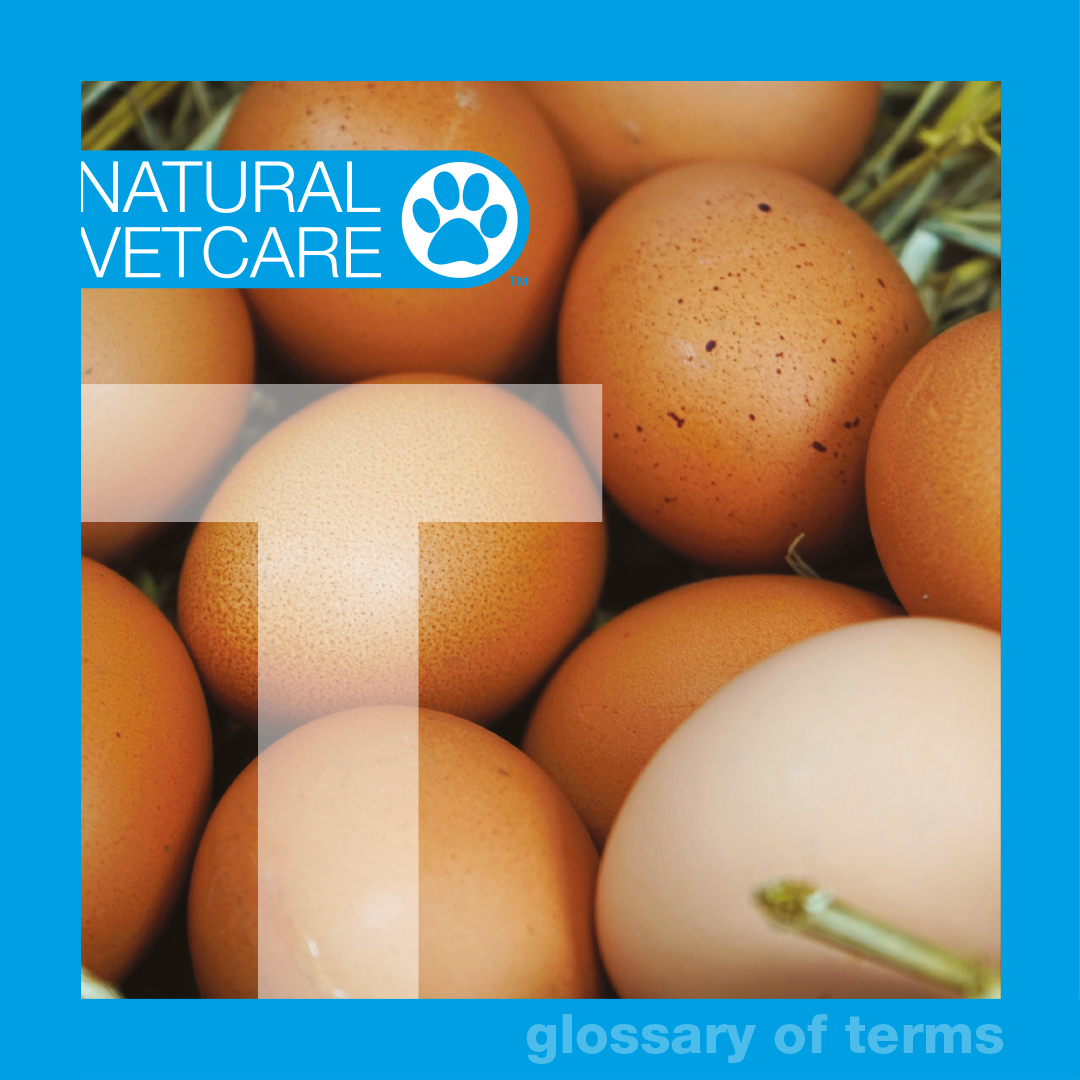
T is for Tryptophan.
Most people have heard of serotonin but how many have heard of its precursor tryptophan?
Tryptophan is an essential amino acid, which means it must be obtained from the diet. It is found in foods such as milk, cheese, chicken, eggs and fish. It has two forms with slightly different orientation - L-tryptophan and D-tryptophan. It is L-tryptophan we are talking about here.
Tryptophan is vital for the synthesis of the neurotransmitter serotonin. Tryptophan competes with other amino acids to get across the blood-brain barrier, which means uptake depends on the relative presence of these competitor amino acids. Increasing the availability of tryptophan produces greater quantities of serotonin.
Tryptophan benefits include better sleep, reduced anxiety, increased emotional wellbeing and improved tolerance to pain. Studies show that dogs with a deficiency in tryptophan are more likely to show aggression, depression and moodiness. Cats supplemented with tryptophan were found to show less stress-related behaviours and were less anxious when living in multi cat households or when placed in unfamiliar locations. Stress in cats often presents as urinary issues so tryptophan is often found in urinary supplements.
Selected References:
1. DeNapoli, J. S. et al (2000) 'Effect of dietary protein content and tryptophan supplementation on dominance aggression, territorial aggression, and hyperactivity in dogs.' JAVMA 217(4) pp.504-508.
2. Landsberg, G., et al (2017) 'Therapeutic effects of an alpha-casozepine and L-tryptophan supplemented diet on fear and anxiety in the cat' Journal of feline medicine and surgery 19(6) pp.594-602.
3. Pereira, G.G., Fragoso, S., Pires, E. (2010) 'Effect of dietary intake of L-Tryptophan supplementation on multi-housed cats presenting stress related behaviors.'' Proceedings of the 53rd BSAVA Congress 2
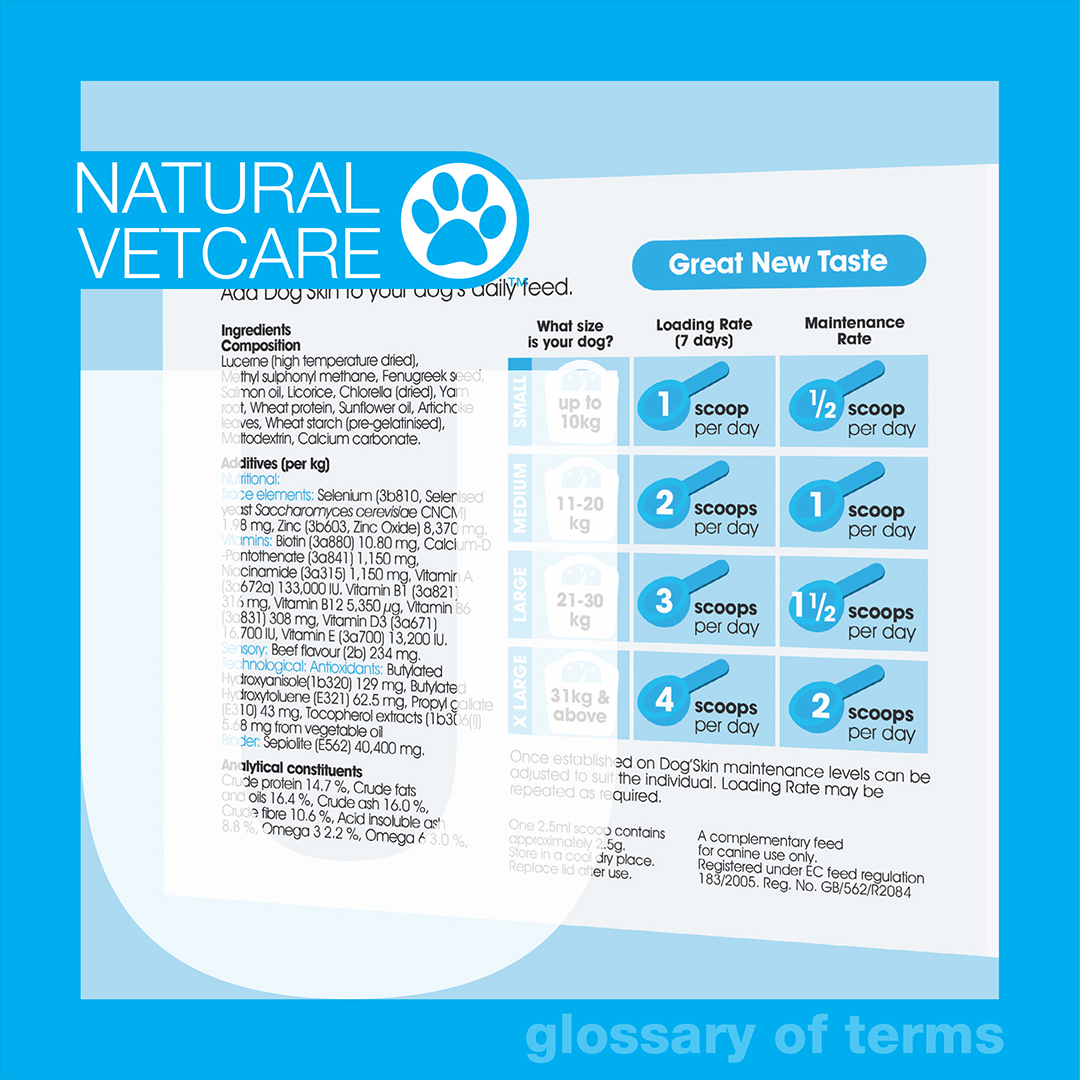
U is for Understanding a label.
All nutritional supplements are considered 'feed' and therefore must adhere to feed labelling legislation.
All labels will have:
- Product name, type and who it is intended for.
- Manufacturer's details including registration number and contact details.
- Ingredients list/composition - this will be in order of inclusion rate, highest to lowest. Exact amounts are not required unless the ingredient has been mentioned in marketing.
- Analysis - levels of protein, oils, ash and fibre. Ash just refers to the mineral content of the product, the inorganic substances that would be left after burning off all the other ingredients. Levels >40% is classed as a 'mineral feed' .
- Instructions on how to feed - it is important that these are followed, over or underfeeding may have undesirable or harmful consequences.
Labels may have:
- Additives list - this is nothing to be concerned by, they are simply the technical ingredients added to help balance the micronutrient requirements, improve quality, palatability and preservation of the product. Examples include vitamins and minerals, amino acids, flavourings and preservatives.
- Quality accreditations - Assurance that the products are manufactured to a good standard e.g. GMP+FSA (Good Manufacturing Process + Feed Safety Assurance).
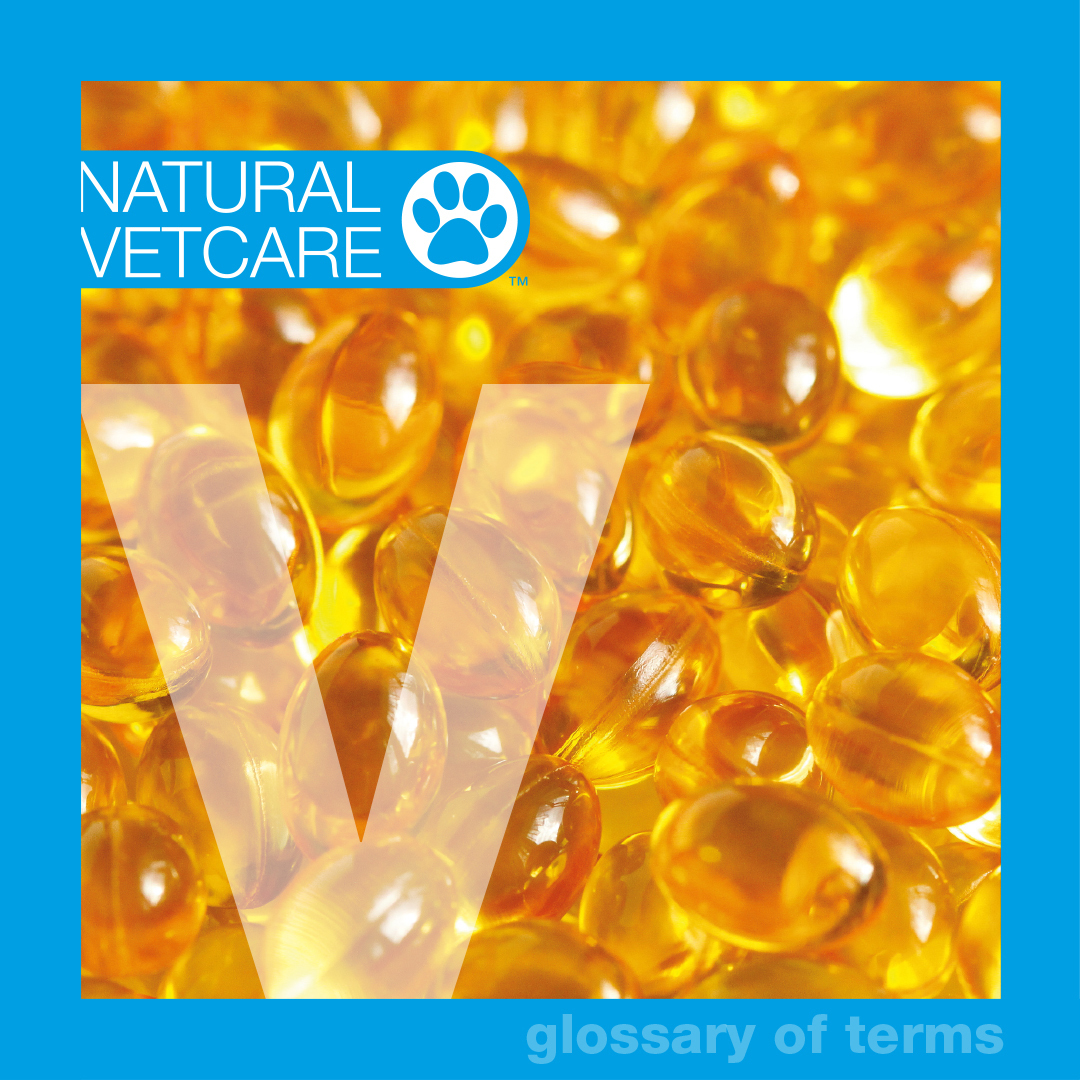
V is for Vitamins.
What do you know about vital vitamins?
They are organic molecules that are essential micronutrients needed in small quantities in the diet for proper metabolic function. Most vitamins are not one single molecule, but groups of related molecules called vitamers, for example there are 8 vitamers of vitamin E.
There are 13 vitamins, are you ready?...A (retinol), B1 (thiamine), B2 (riboflavin), B3 (niacin), B5 (pantothenic acid), B6 (pyridoxine), B7 (biotin), B9 (folic acid), B12 (cobalamin), C (ascorbic acid), D (calciferol), E (tocopherol), K (phylloquinone).
Vitamins are classed as either water soluble (Bs and C) or fat soluble (A, D, E, K). Excess water soluble vitamins are generally passed uneventfully in the urine, however, they are not stored so consistent uptake is vital. Fat soluble vitamins can accumulate in fat therefore excess intake of these vitamins can lead to problems.
Vitamins exhibit many diverse biochemical actions including roles in energy and protein metabolism, the nervous system, the immune system, eyesight, blood clotting and as antioxidants.
Inadequate intake in the diet can lead to deficiencies and well-known diseases such as scurvy (vitamin C) and rickets (vitamin D). Vitamin K deficiency can occur in liver disease or after ingestion of rat poison. Supplements often contain vitamins C and E for their antioxidant role, while the B vitamins are useful in supplements aimed at animals with skin issues or chronic disease.
Selected References:
1. National Research Council (2006) 'Nutrient Requirements of Dogs and Cats' The National Academies Press
2. Williams, I. (2014) 'The Importance of the B Vitamins' Veterinary Practice
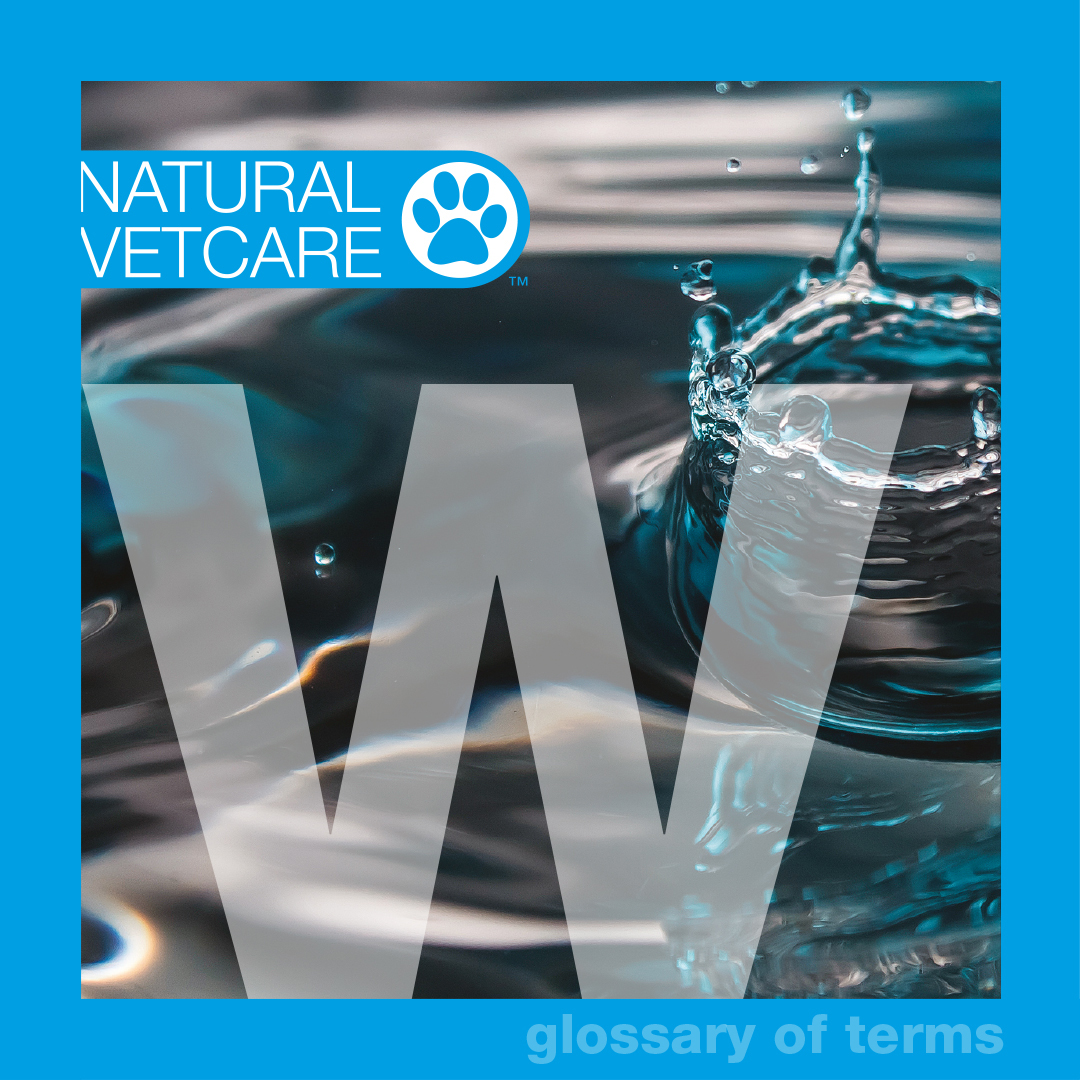
W is for Water.
The most important nutrient of all!
Dogs and cats are made of approximately 60% water, for a 20kg dog this equates to 12 litres! Greyhounds can be up to 70% water due to lower fat content. Severe dehydration, and likely death, results at only 8% loss. In comparison animals can lose almost 100% of their body fat and 50% of their protein and still survive.
Water is distributed into different body compartments - two thirds in the intracellular fluid (inside cells), one third in the extracellular fluid. The extracellular fluid is further divided into interstitial fluid (around the cells), intravascular fluid (within blood vessels) and transcellular fluid (cerebrospinal fluid, gastrointestinal fluid, synovial fluid, bile, glandular and respiratory secretions). All of these compartments are in a dynamic equilibrium, with water and electrolytes moving between them.
Animals consume water by drinking and from their food, plus a small amount is produced during digestion. A rough guide for intake through drinking is 50ml/kg/day, so approximately 1 litre a day for a 20kg dog. Water is needed for digestion, nutrient absorption and transport. It is involved in many chemical reactions within the body and regulates and maintains normal body temperature. It is also required to remove waste from the body in the form of urine and faeces.
Insufficient water intake puts excess strain on the kidneys and urinary system and can result in kidney damage and urinary issues. Contact NVC to discover more about maintaining your pet's kidney and urinary health.
Selected References:
1. Case, L.P. (2014) 'Dog Food Logic' Dogwise Publishing p.58
2. Wellman, M.L. et al (2016) 'Applied Physiology of Body Fluids in Dogs and Cats' veteriankey.com
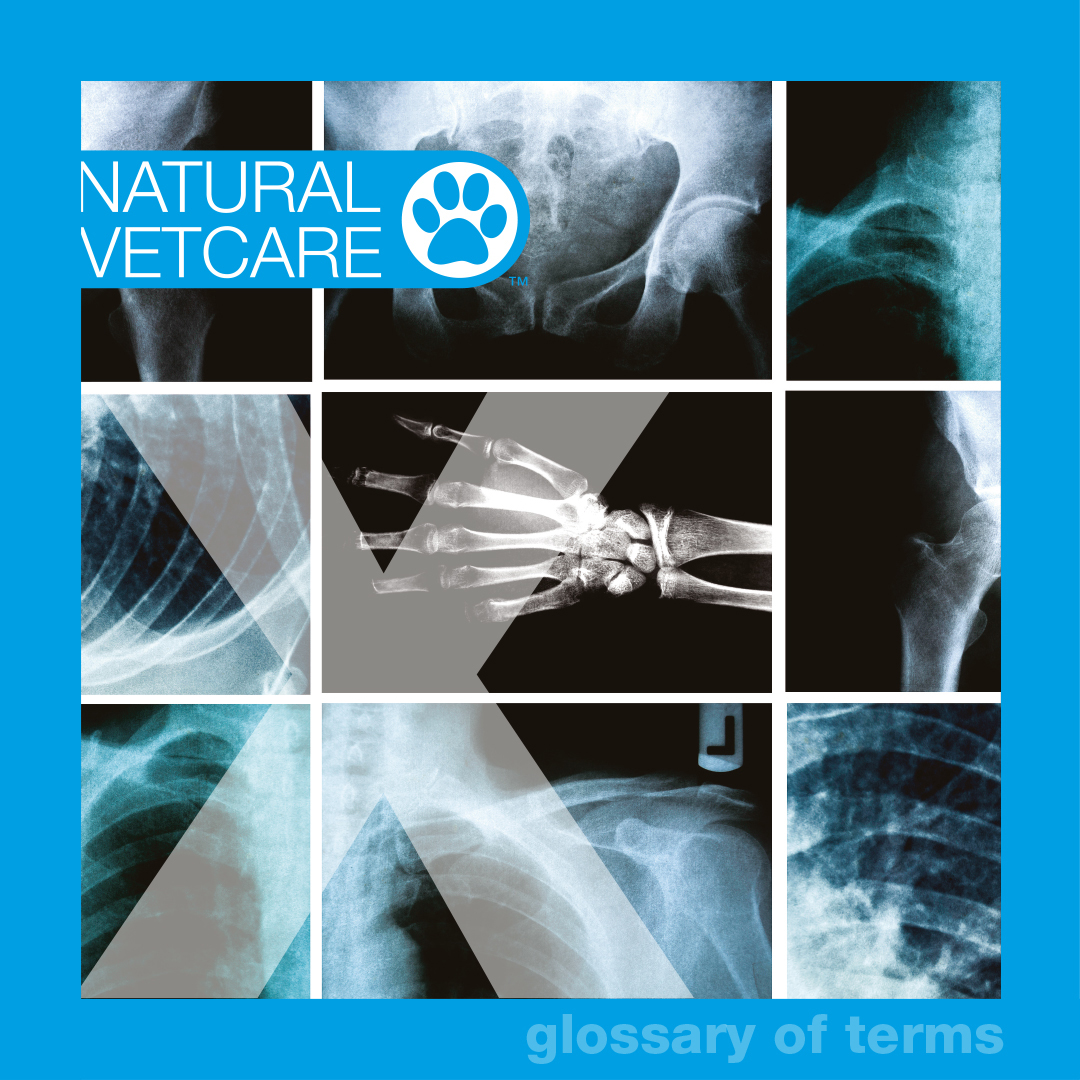
X is for X-ray.
Many pets suffer from stiffness and lameness as they age and your vet might suggest taking an x-ray to assess further. Often these x-rays will reveal arthritic changes. Osteoarthritis, or degenerative joint disease, is a progressively worsening inflammation of the joint due to deterioration of cartilage. The cartilage acts as a cushion for the joint. Age, injury or repetitive stress causes this protective cushion to break down resulting in pain, inflammation and a reduced range of motion. Small growths of bone, called osteophytes, appear around the affected joint and these can be seen on an x-ray. Sometimes the x-ray can also detect soft tissue swelling around a joint, indicating that the joint is quite inflamed and unhappy.
However, it is important to remember a few things. The bony changes visible on an x-ray often occur late into the course of the problem, when a lot of joint damage has already occurred. Also, it is not easy to tell the degree of pain the animal is likely to be in just from an x-ray. While obvious changes on the x-ray let you know arthritic change has already happened, absence of those changes does not mean that the animal does not have inflammation, pain or damage to the cartilage.
Here at Natural VetCare we recommend thinking about your dogâs joint health before these obvious changes have already occurred. Supplements aimed at maintaining joint integrity are best started while there is still cartilage there to maintain, all the more important in large breed or hard-working dogs.
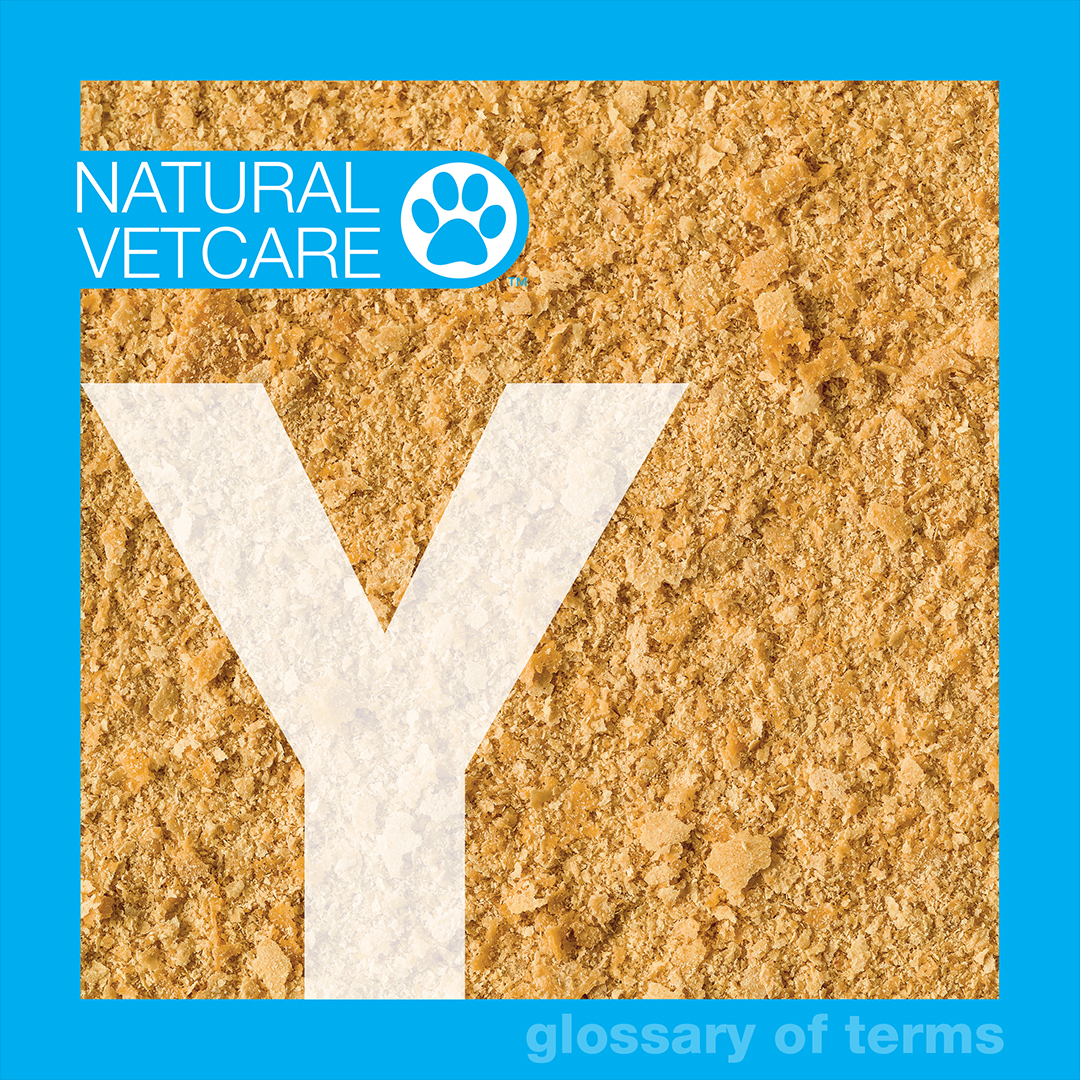
Y is for Yeast.
Did you know that your pet's skin is home to yeast organisms, namely an organism called malassezia?
Small numbers are harmless but when numbers increase, an itchy and smelly condition called malassezia dermatitis can result. Some dogs are even allergic to the proteins in the yeast organisms and have symptoms of dermatitis even with low numbers of yeast. Westies and Cocker Spaniels are among the breeds predisposed to this problem.
You might notice that your dog has a yeasty smell to their coat, has a pinky discolouration to their fur or are itchier than normal. Typical locations affected are the feet and ears and in severe cases the skin can start to resemble that of an elephant, a process known as lichenification. Some cases will require a special shampoo or cream, anti-itch medication or even oral anti-fungal medication.
It is important to remember that yeast overgrowth is usually a secondary reaction to a primary problem, such as allergic skin disease or seborrhea, a condition where the dogâs skin produces more oil than normal. It is important to maintain the health of your dogâs skin to try and reduce the frequency and severity of yeast overgrowth flare-ups. Omega 3 fatty acids have been shown to reduce itchiness, while the addition of antioxidants, digestive support and a broad spectrum of vitamins and minerals can help maintain optimal skin health and immunity to help reduce the consequences of yeast overgrowth.
Selected References:
1. Bauer, J. (2011) 'Therapeutic use of fish oils in companion animals' JAVMA 239 (11) pp. 1441-1451
2. Pham-Huy et al (2008) 'Free Radicals, Antioxidants in Disease and Health' International Journal of Biomedical Science 4(2) pp. 89-96p>
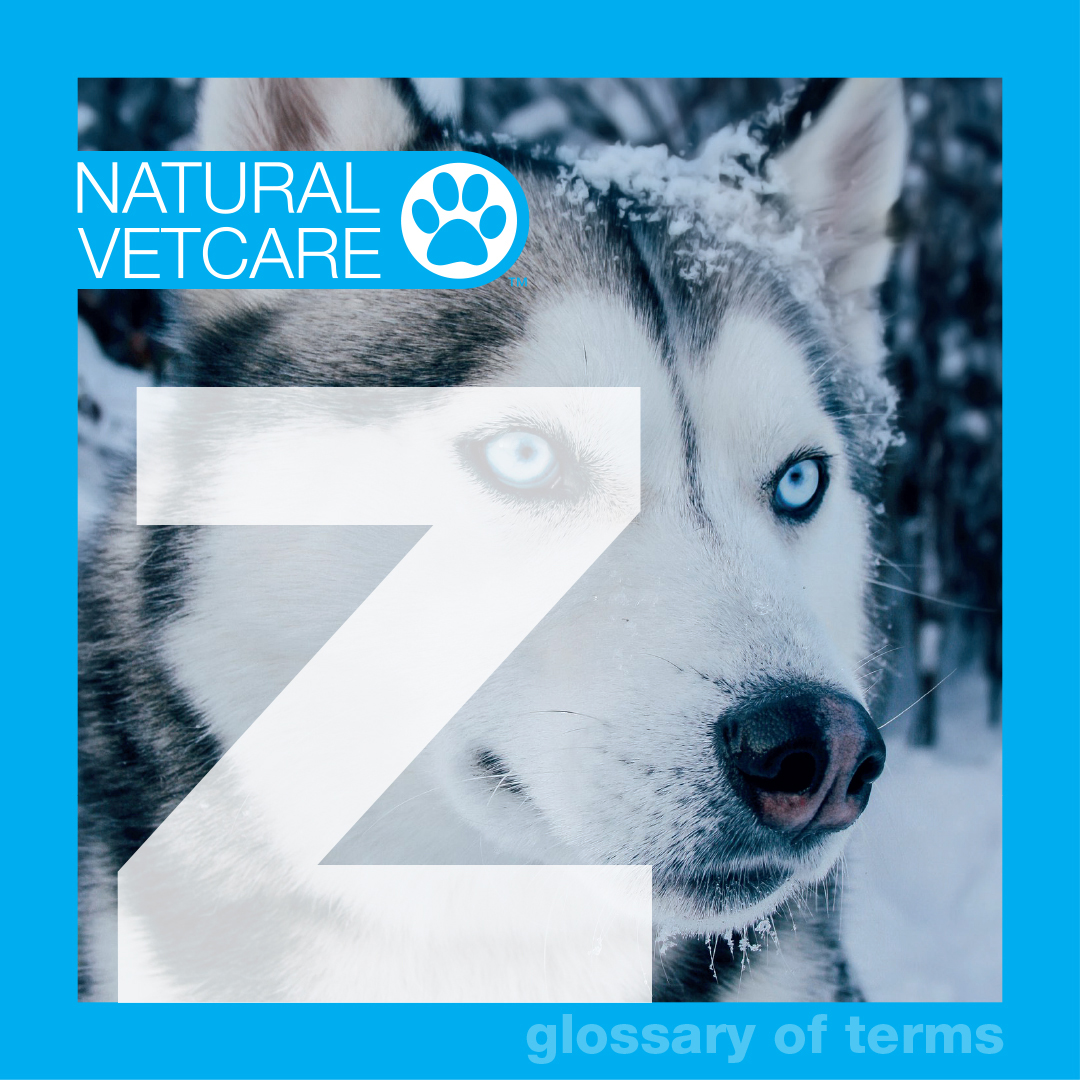
Z is for Zinc.
How much do you know about this essential trace element?
Zinc is termed essential as the body cannot produce any itself, it must be obtained from the diet. It can be found in a variety of sources such as red meat and wholegrains. However, different factors can affect its absorption, such as the presence of phytates in the diet. Phytates come from phytic acid, found in many plant-based foods, including beans, seeds and nuts. Phytates have been termed anti-nutrients as they can reduce the absorption of certain minerals including zinc, calcium, magnesium, iron, chromium and manganese. There is some evidence that extrusion cooking may inhibit the degradation of dietary phytic acid in the gut, resulting in less efficient absorption of zinc in extruded (kibble) pet foods.
Zinc is found in most tissues in relatively low concentrations and is required as the cofactor or catalyst in 200 zinc-containing enzymes involved in cell replication, carbohydrate and protein metabolism, skin function and wound healing.
Zinc deficiency is a problem in certain breeds, including Huskies and Alaskan Malamutes, due to a genetic defect resulting in interference in zinc absorption. These dogs need to be given lifelong zinc supplementation. However, zinc deficiency can also occur in any breed due to dietary insufficiencies, either through genuinely deficient levels present in the diet or factors affecting its absorption in the gut, such as the presence of phytates mentioned above. Zinc deficiency presents as poor growth and crusty skin lesions around the face and feet. Rapidly growing large breed puppies are more at risk of a dietary zinc deficiency. Symptoms can usually be reversed with supplementation.
Selected References:
1. King, J., Keen, C. (1994) 'Zinc' pp.214-230 in modern Nutrition in Health and Disease. Lea and Febiger, Philadelphia
2. National Research Council (2006) 'Nutrient Requirements of Dogs and Cats' The National Academies Press, Washington D.C.
CONTACT
Copyright © Natural VetCare 2019
Security & Privacy | Cookies | Terms & Conditions





